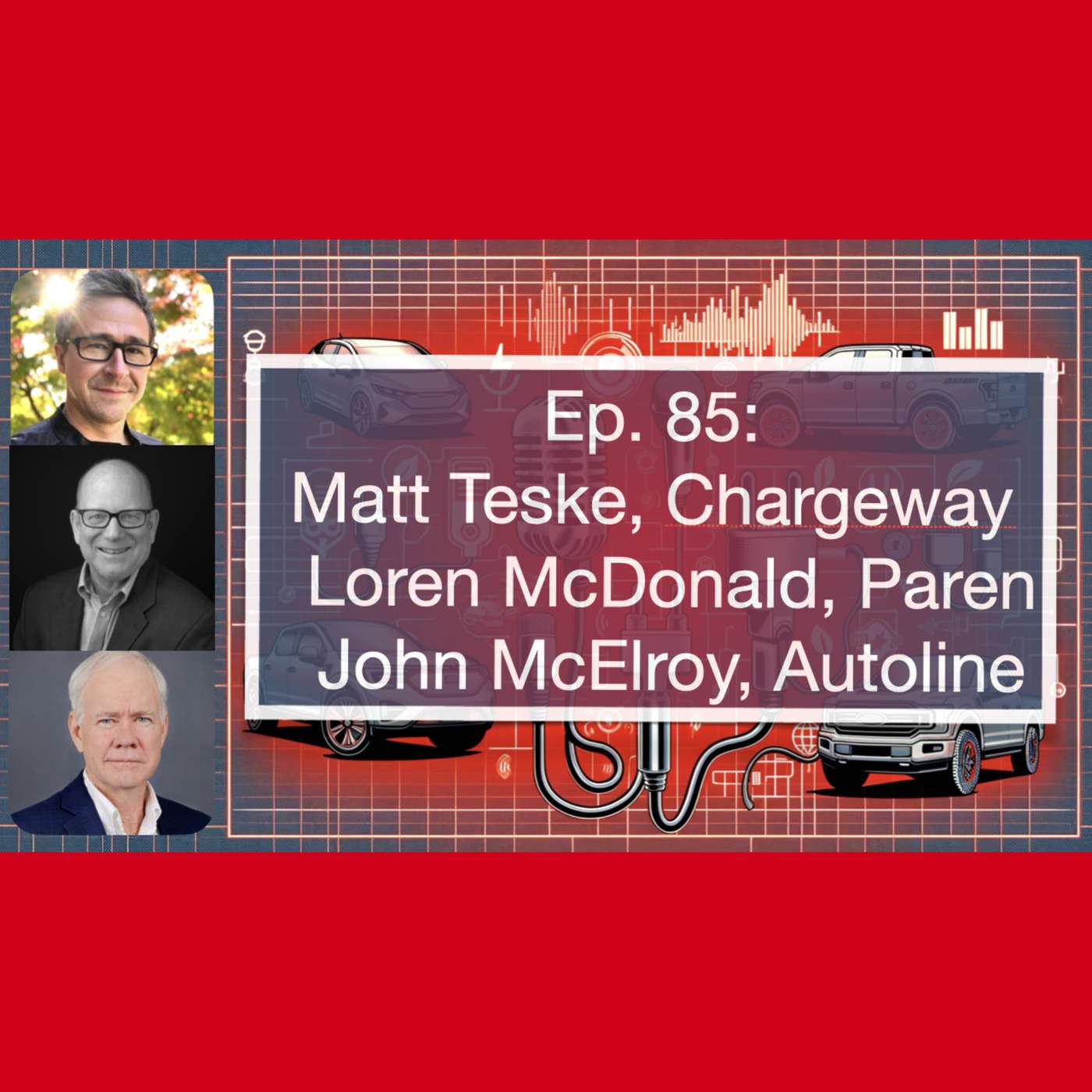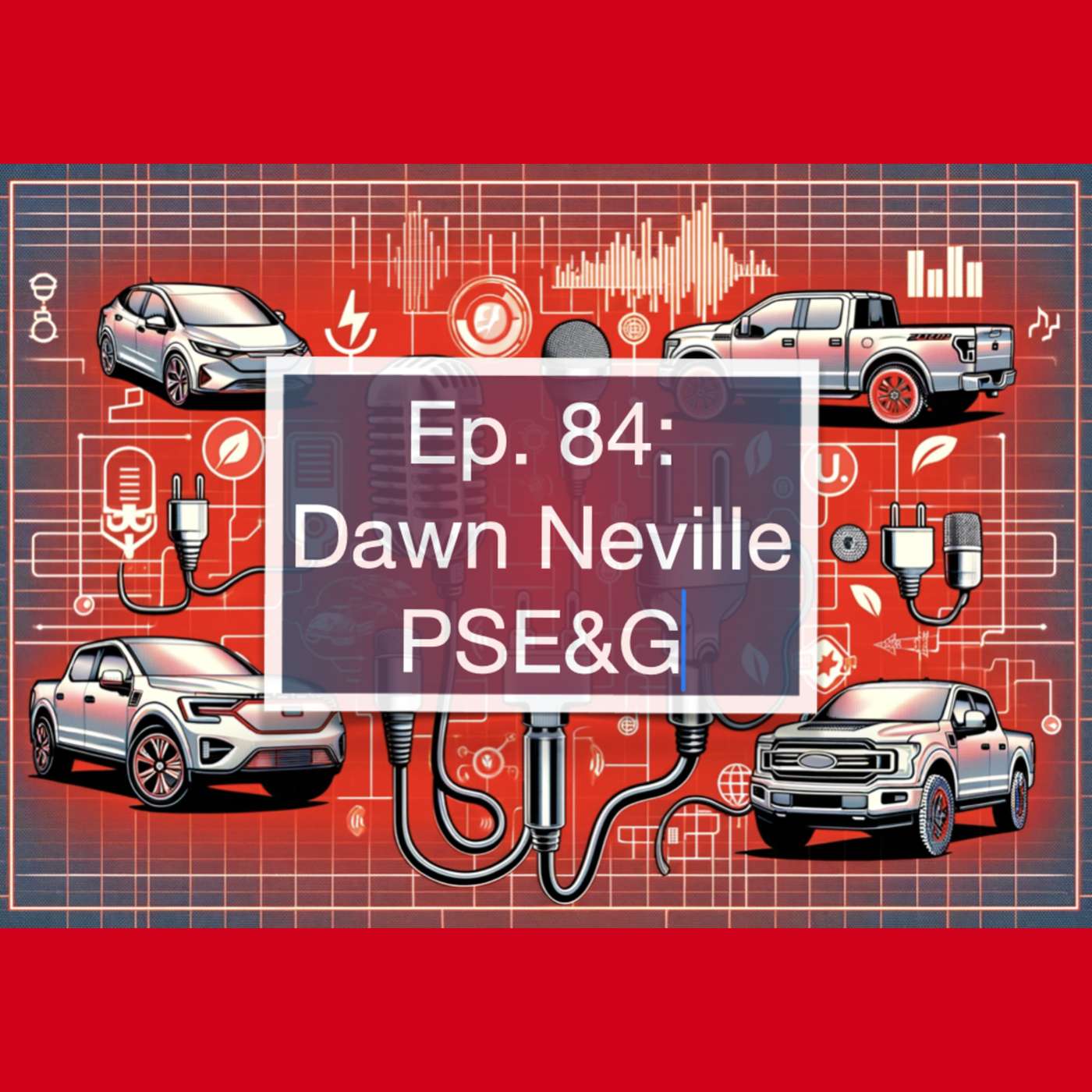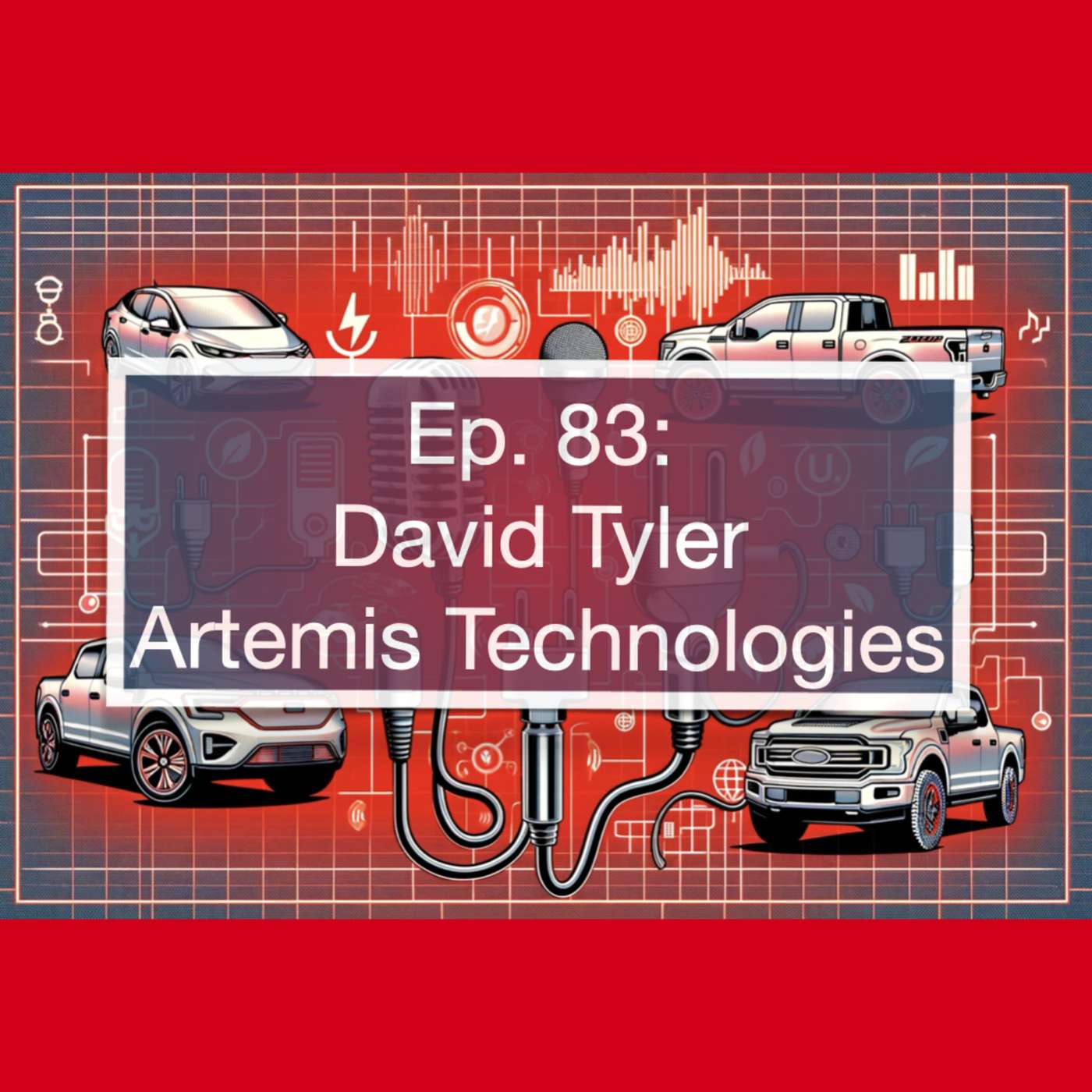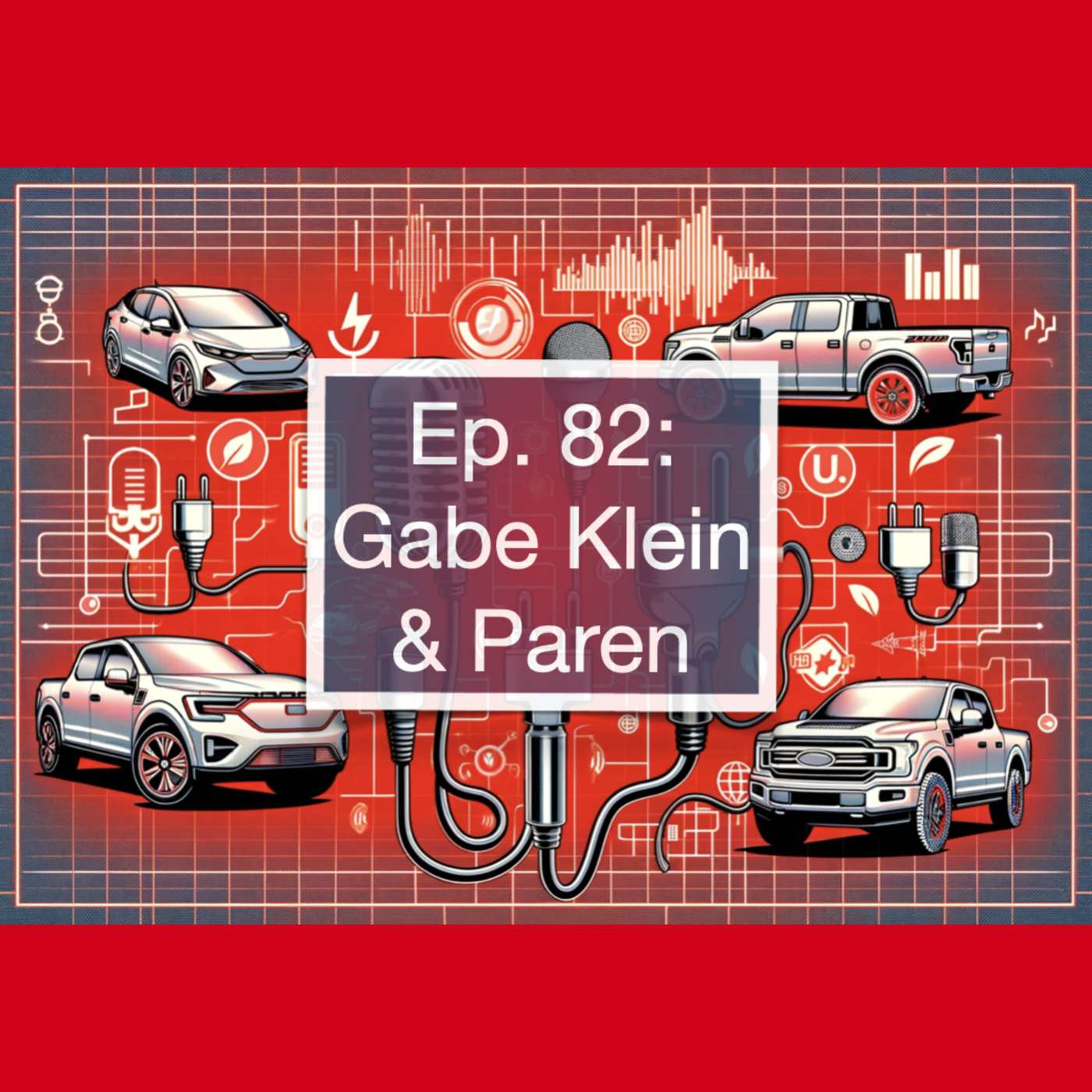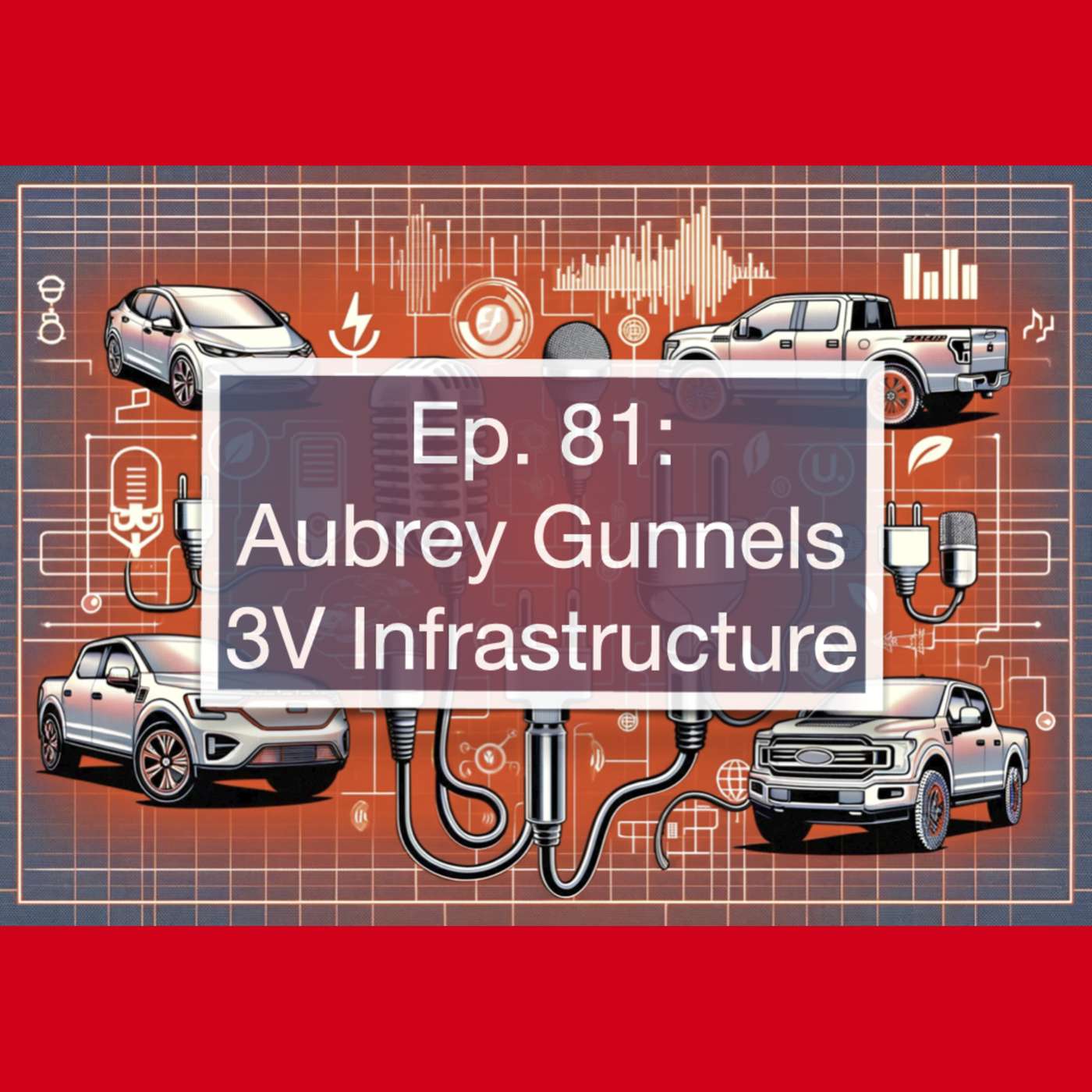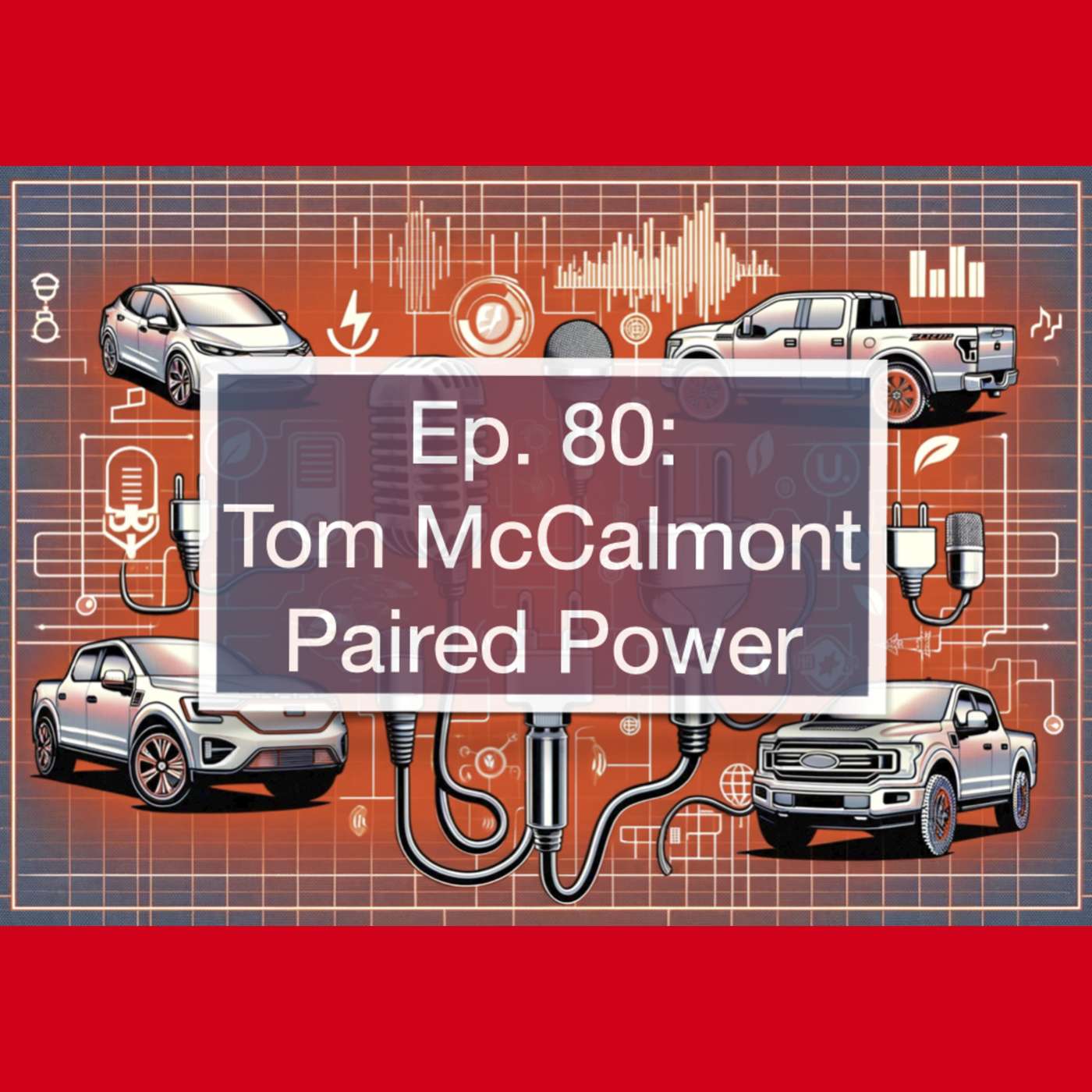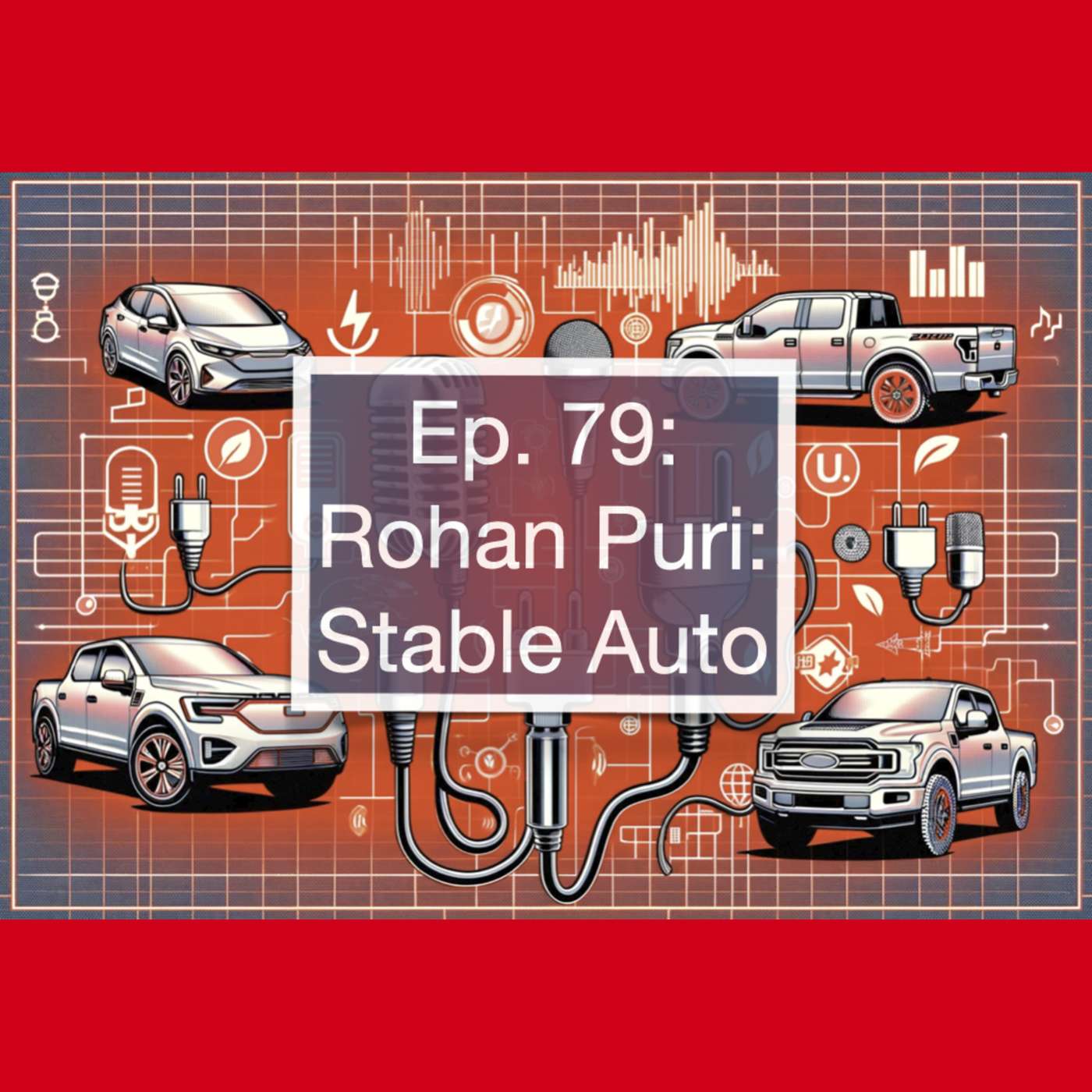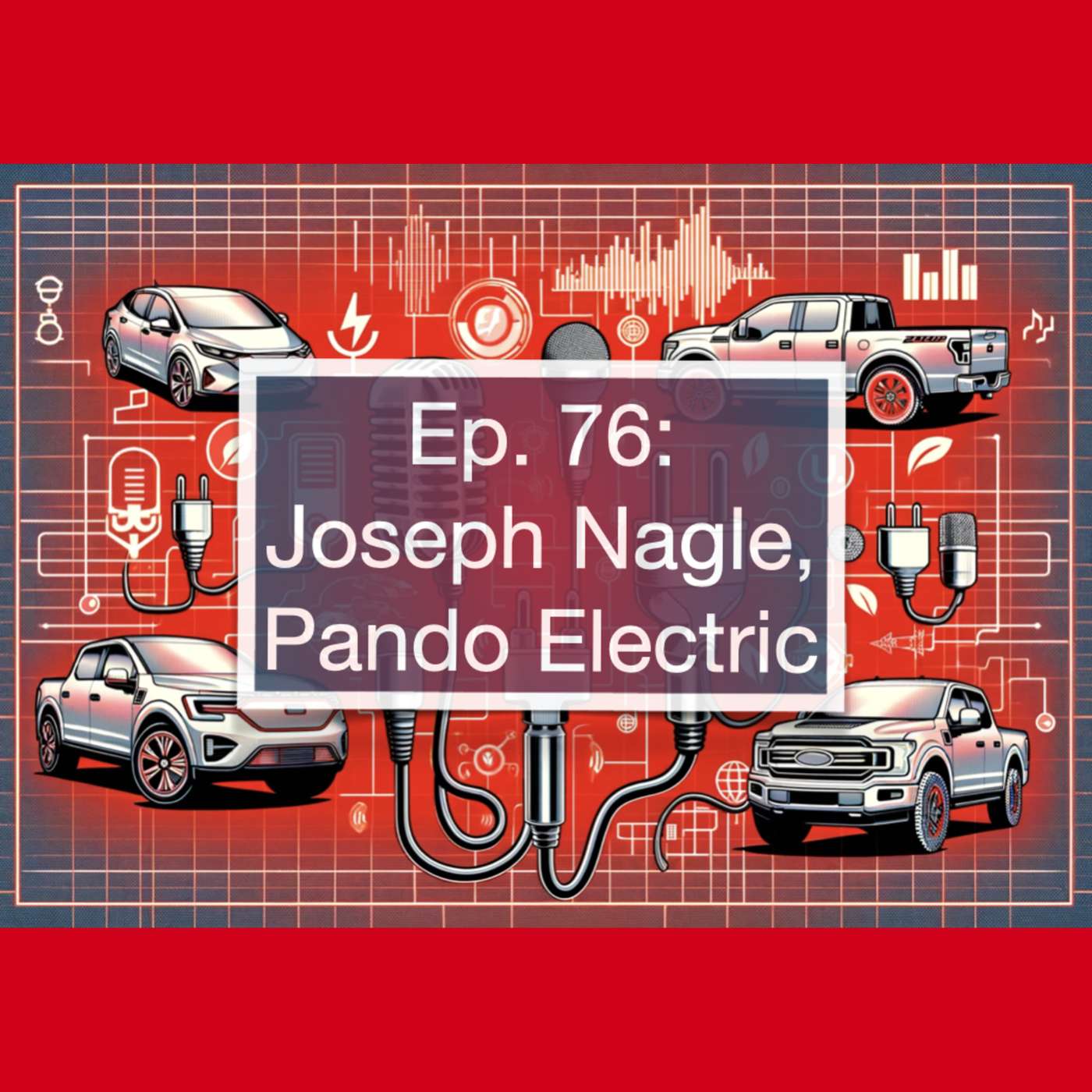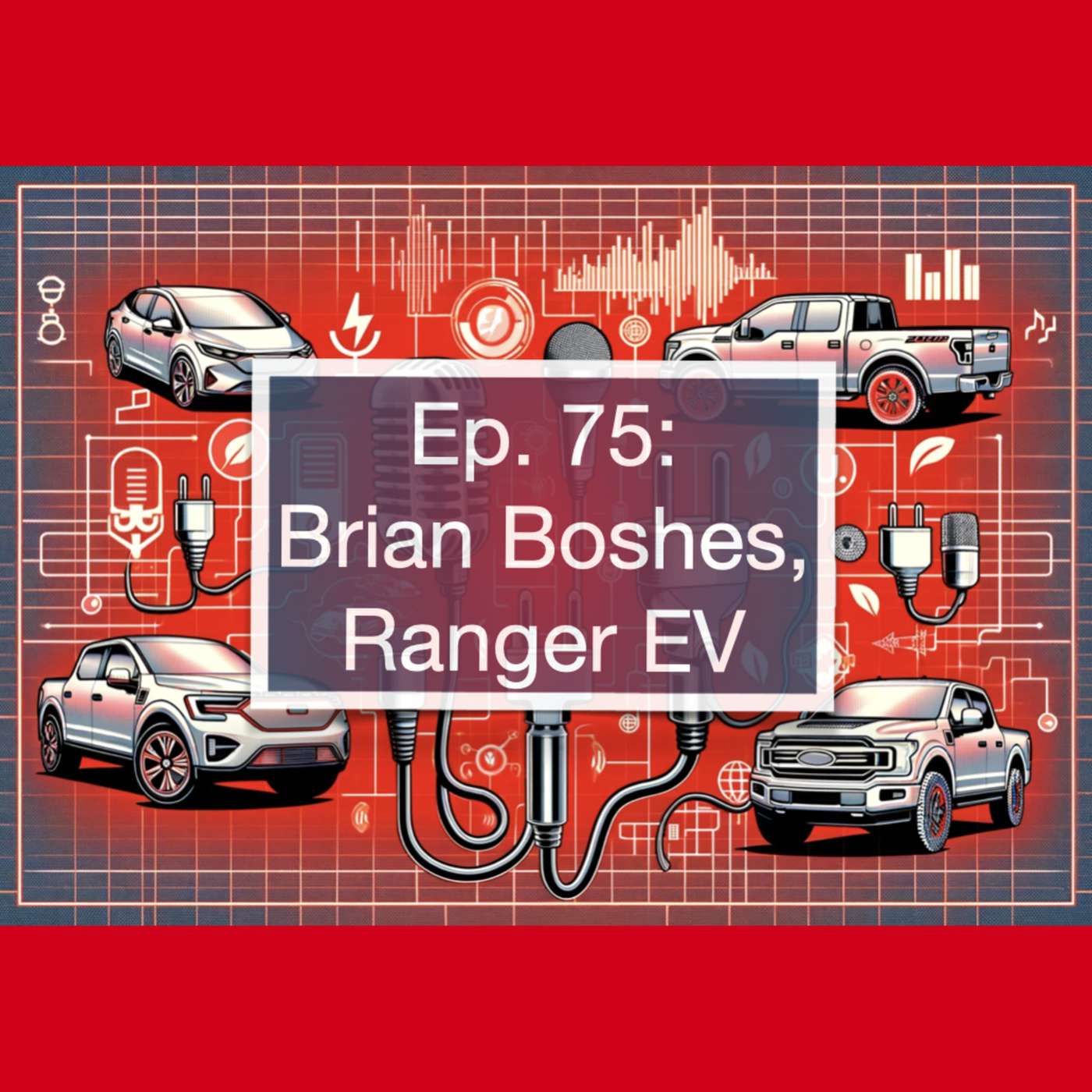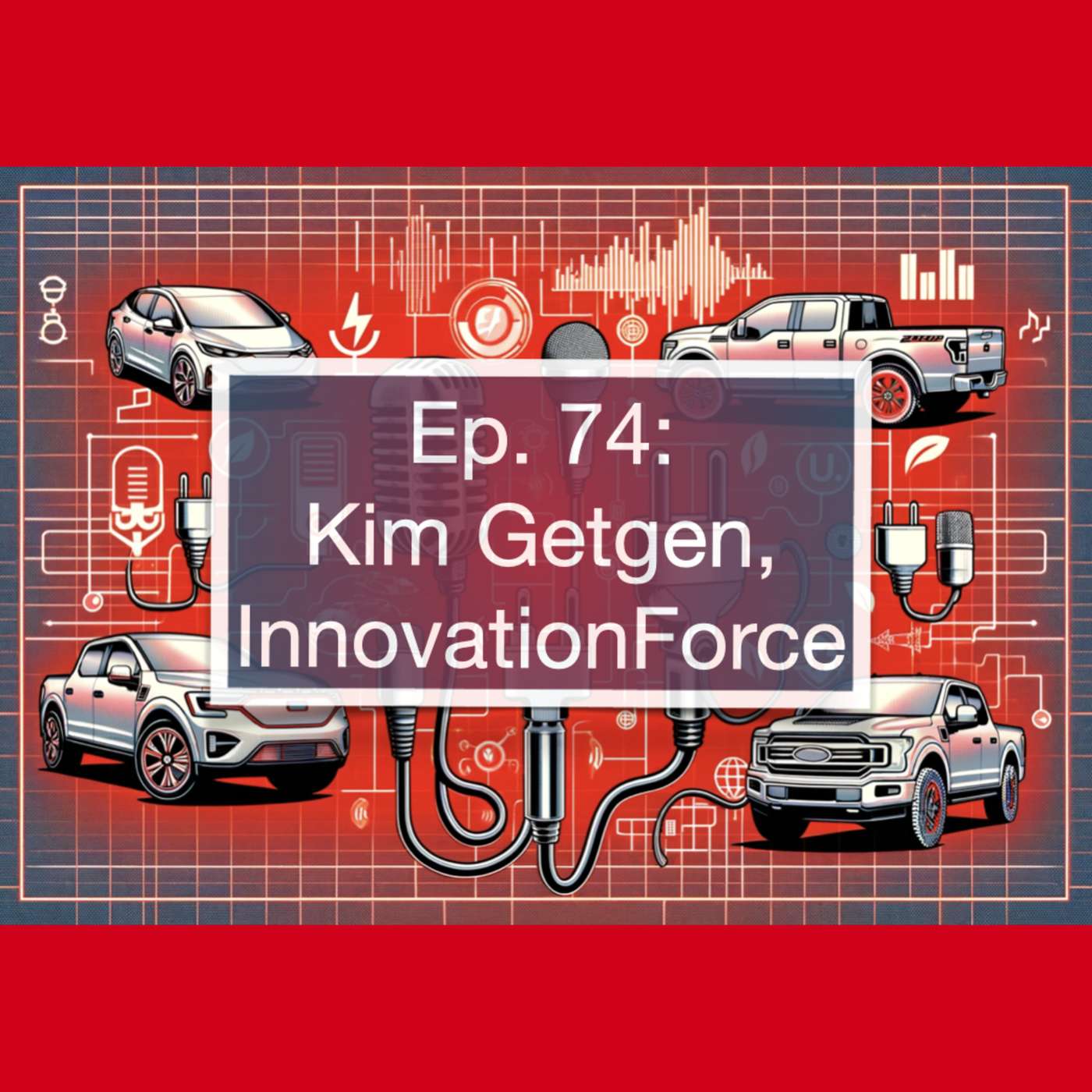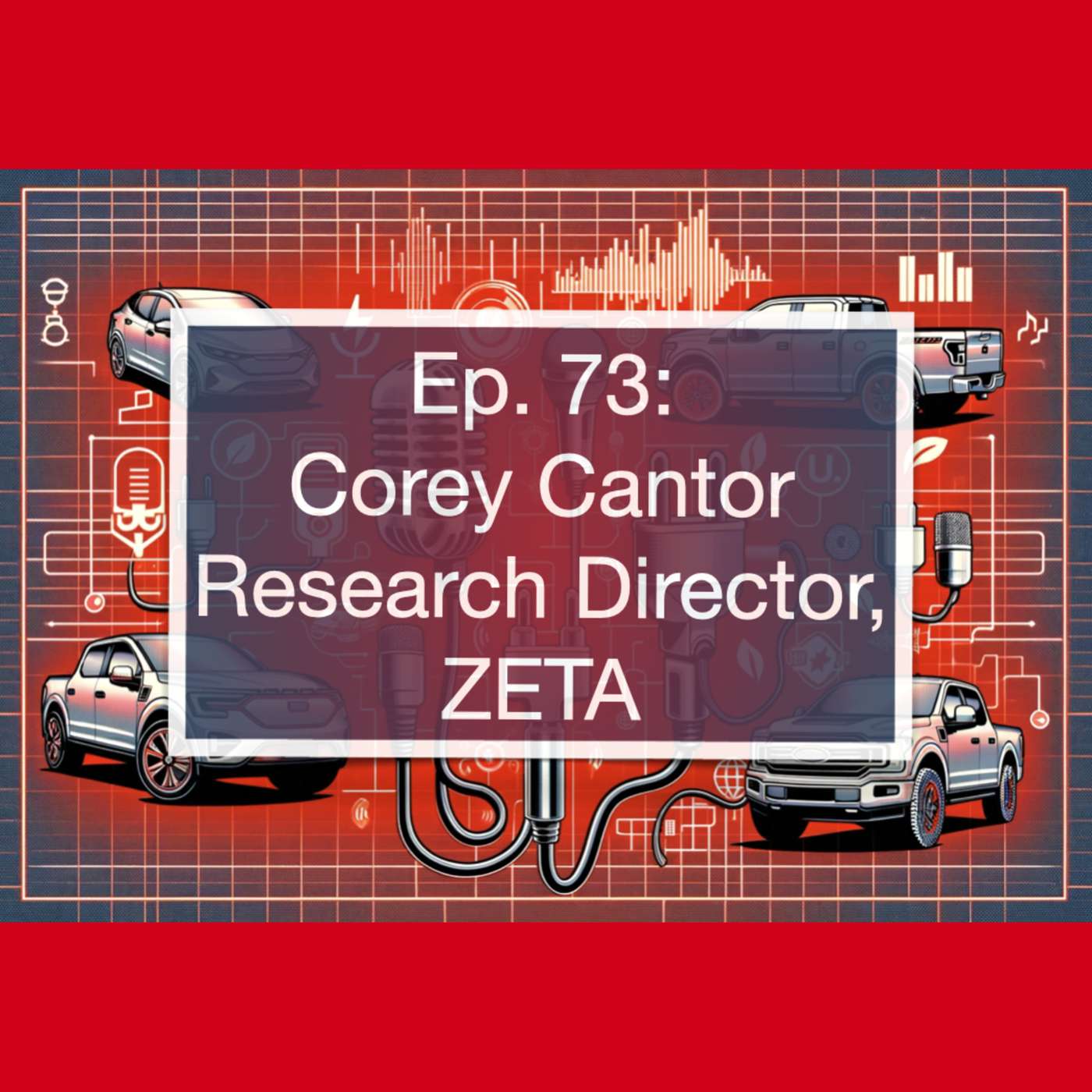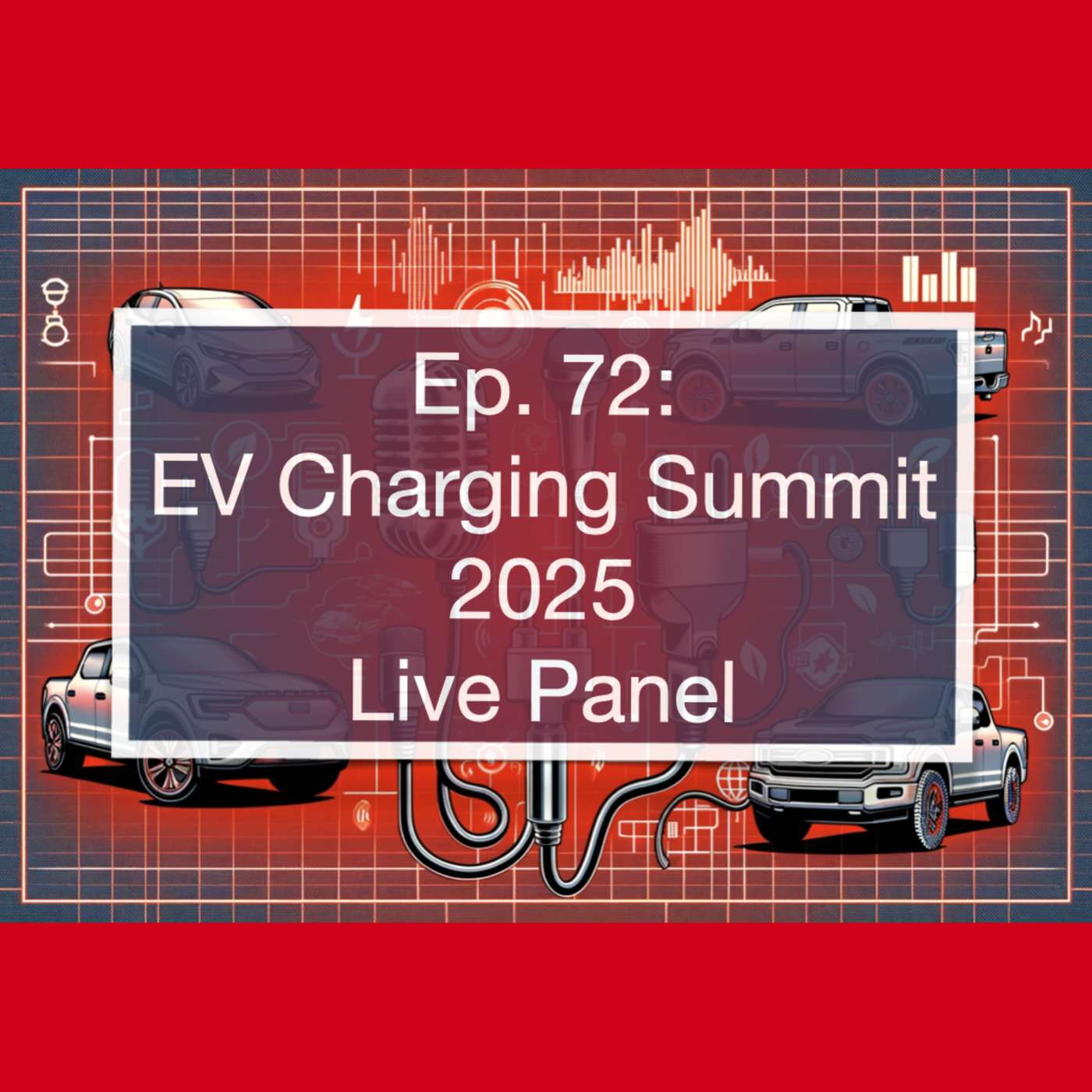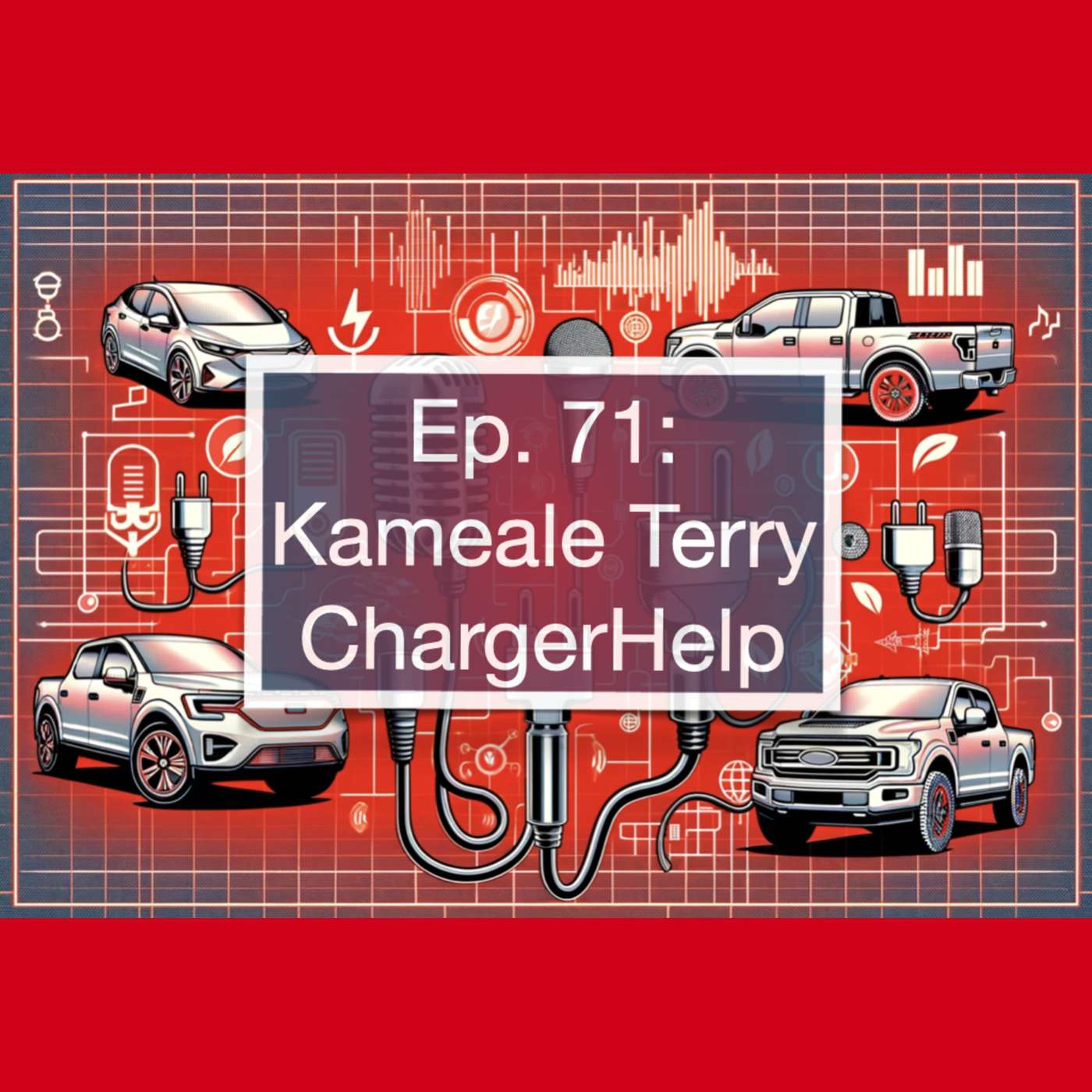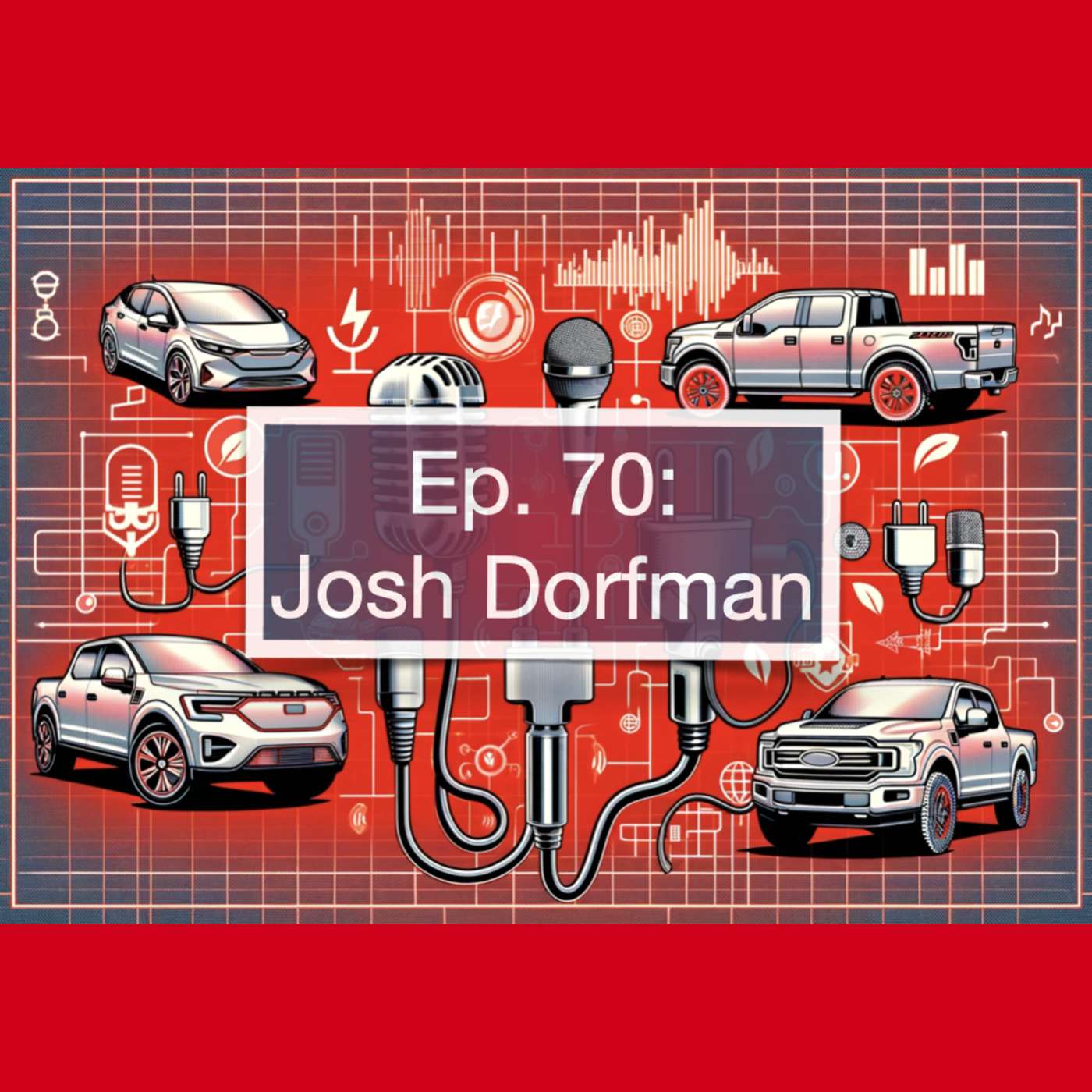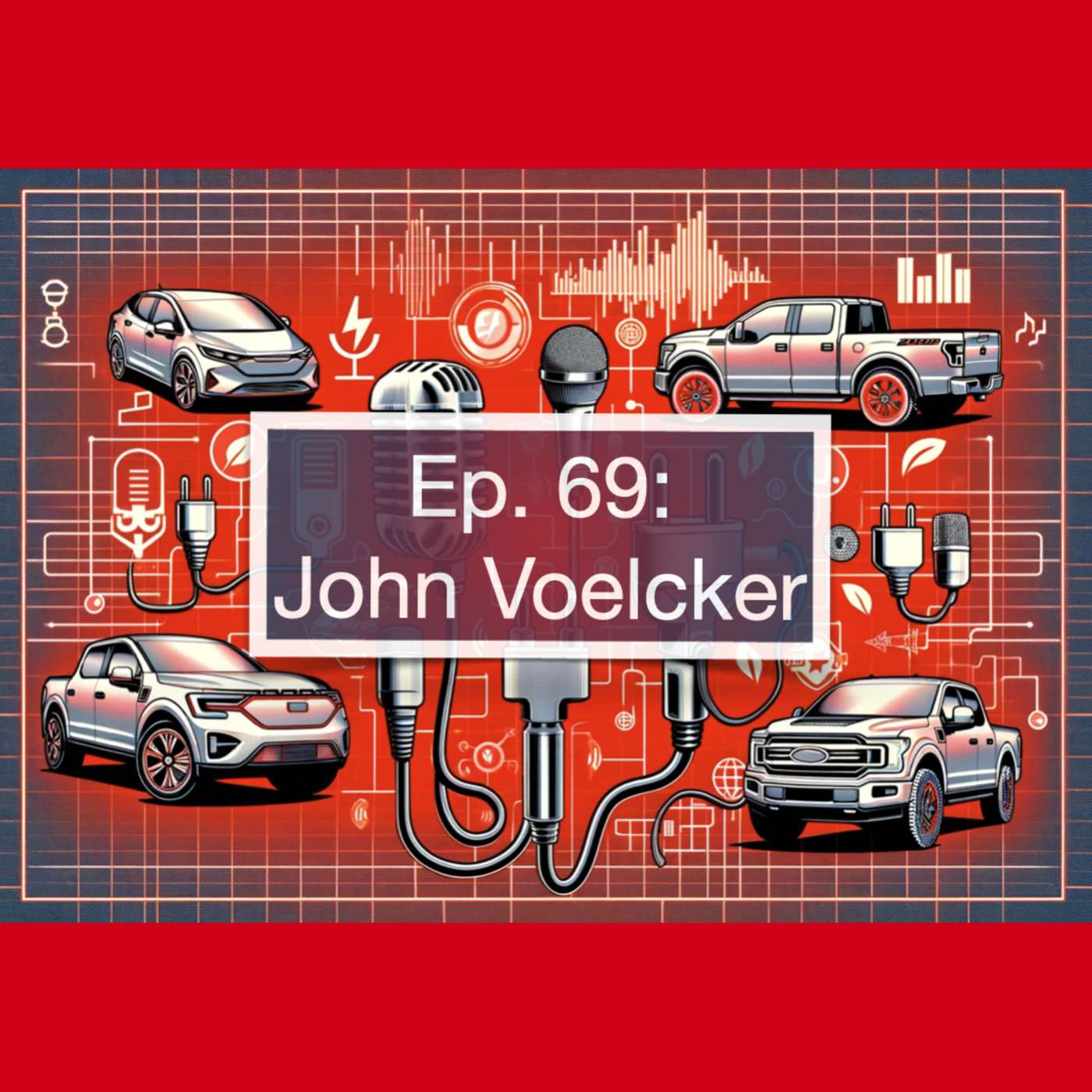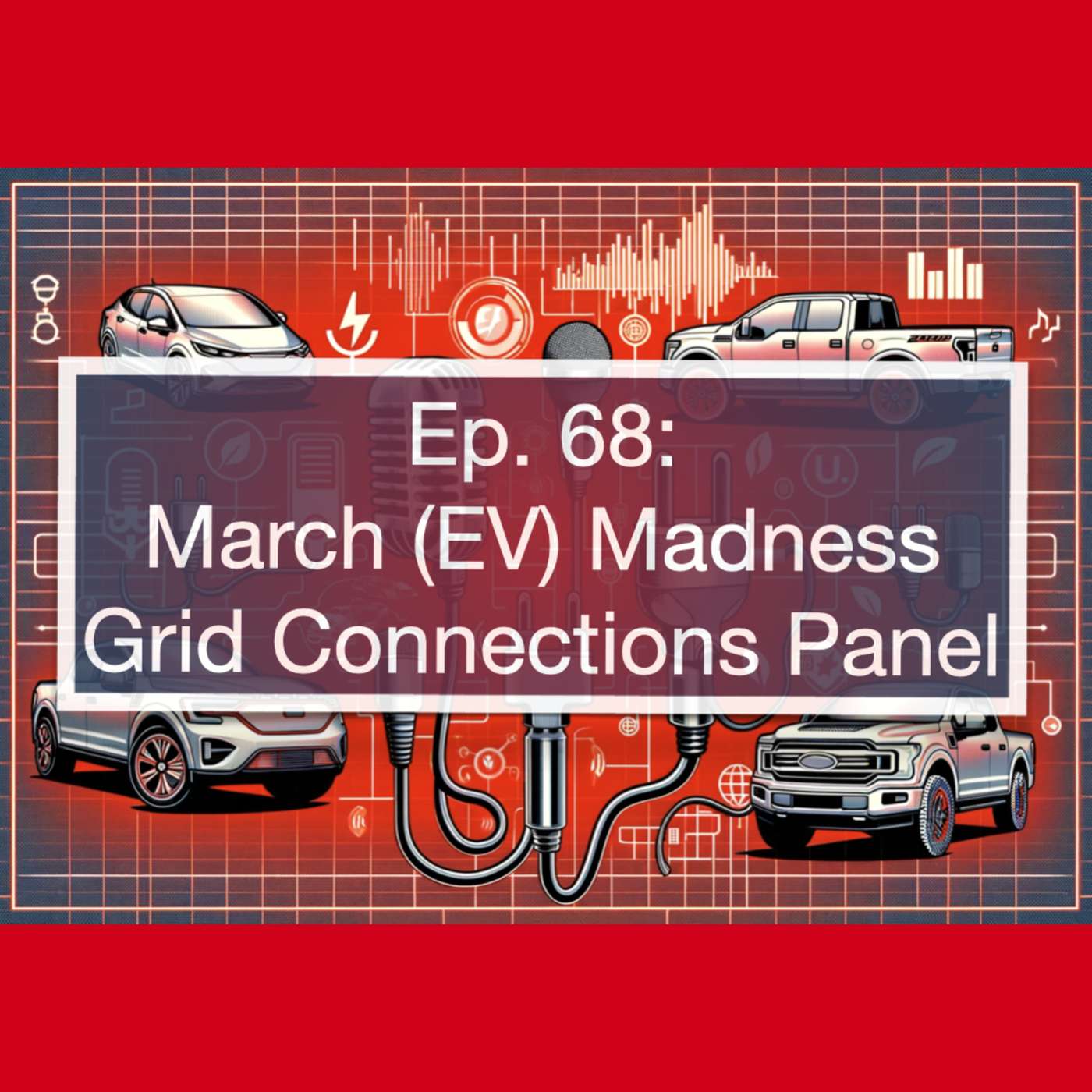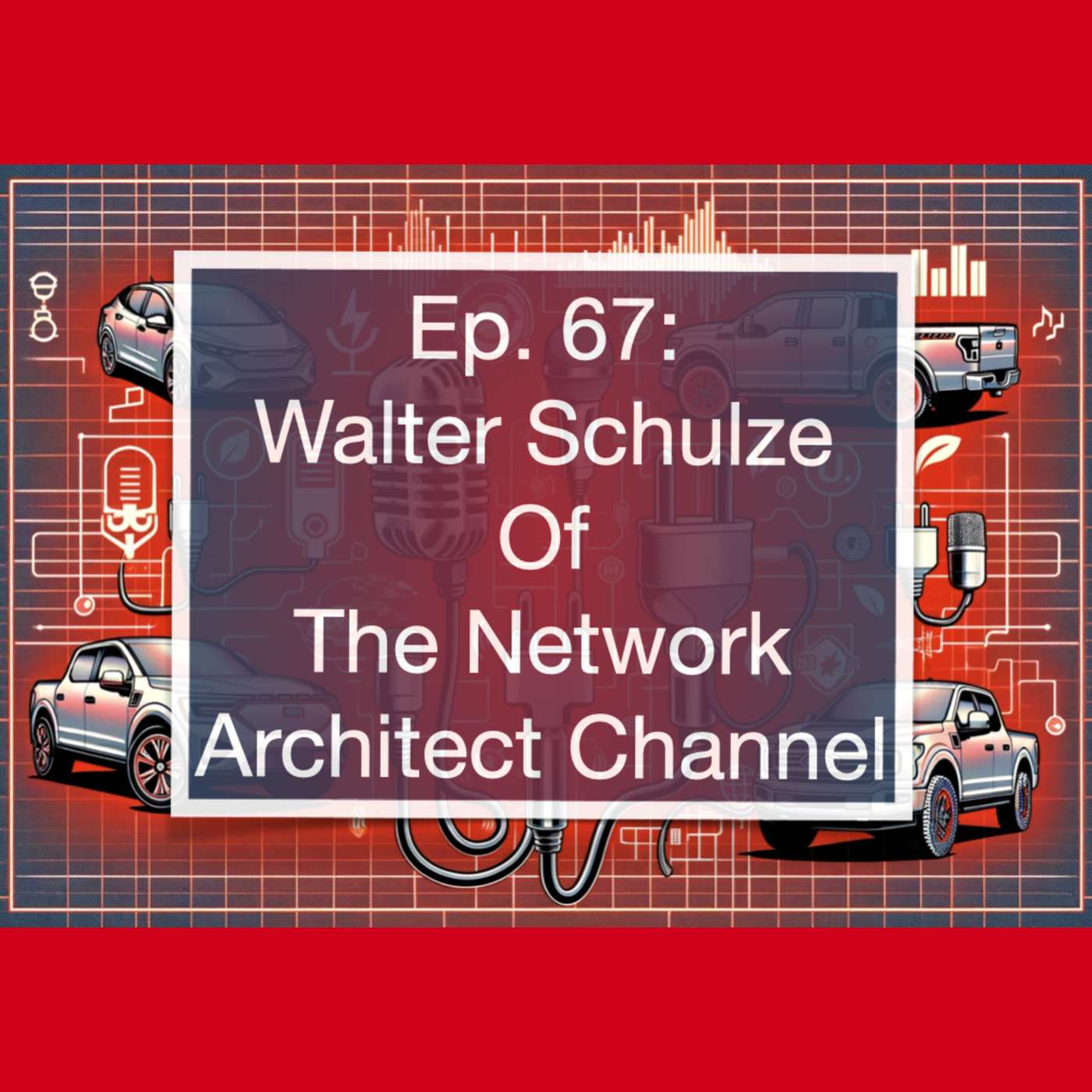Discover Grid Connections
Grid Connections

Grid Connections
Author: Grid Connections
Subscribed: 25Played: 927Subscribe
Share
e.g. © 2024 Grid Connections
Description
Discover the future of energy in the Grid Connections Podcast. Join our expert host as we explore the latest innovations and developments in the world of renewable energy, electric vehicles, and sustainable transportation.
In each episode, we dive deep into topics such as the future of electric vehicles, charging infrastructure, and the impact of renewable energy on our society. We'll discuss cutting-edge technology, industry trends, and the challenges faced by those working to create a more sustainable future.
By listening to the Grid Connections Podcast, you'll gain valuable insights and knowledge from industry experts, policymakers, and thought leaders. You'll also have the opportunity to stay up-to-date on the latest developments in the world of sustainable energy and transportation.
Don't miss out on this exciting and informative podcast. Download the Grid Connections Podcast today and join us on our journey towards a cleaner, reliable future.
In each episode, we dive deep into topics such as the future of electric vehicles, charging infrastructure, and the impact of renewable energy on our society. We'll discuss cutting-edge technology, industry trends, and the challenges faced by those working to create a more sustainable future.
By listening to the Grid Connections Podcast, you'll gain valuable insights and knowledge from industry experts, policymakers, and thought leaders. You'll also have the opportunity to stay up-to-date on the latest developments in the world of sustainable energy and transportation.
Don't miss out on this exciting and informative podcast. Download the Grid Connections Podcast today and join us on our journey towards a cleaner, reliable future.
87 Episodes
Reverse
Summary On this episode we talk with Steve Gutmann and Robert Wallace about making electric vehicles practical, affordable, and appealing for rural drivers through the new EVMath program. Drawing from their work on agricultural electrification and hands-on experience with EVs like the Tesla Model 3, Rivian, and Ford F-150 Lightning, Steve and Robert share how low rural electricity rates, high gas prices, and at-home charging can make EV ownership cheaper than running a diesel pickup—often with fuel savings exceeding the monthly payment. They discuss the eFarms program’s real-world testing of electric farm equipment, the surprising utility and range of EVs in remote areas, and the potential of vehicle-to-home power for resilience during outages. With EVMath’s online calculator, case studies, and resources, rural residents can see exactly how switching to electric can save money, increase convenience, and keep more energy dollars in their communities.⚡ Tune in now and don’t forget to Subscribe to our new newsletter!Plus check out our new consultancy site: Grid Connections ConsultingTakeaways1. Rural EV Ownership Can Slash Driving Costs by 80% or More Robert Wallace’s switch from a diesel pickup to a used Tesla Model 3 dropped his fuel cost from over 20¢ per mile to just 2–3¢ per mile—proving EVs can dramatically reduce transportation expenses in rural communities.2. EVs Offer Surprising Utility for Country Living From hauling livestock feed and farm tools to loading up 50-pound bags of dog food, EVs like the Tesla Model 3 have unexpected cargo space and functionality that rival or exceed many gas-powered vehicles.3. Electric Farm Equipment Brings Big Advantages Beyond Zero Emissions Programs like eFarms are putting electric tractors, trucks, and side-by-sides into the hands of farmers—offering quiet operation, instant torque, and even mobile power for running irrigation pumps in remote fields.4. Destination Charging Can Be More Useful Than DC Fast Charging For many rural drivers, Level 2 chargers at hotels, workplaces, or meeting locations are more than enough to recharge during the day—reducing the need for constant DC fast charger access.5. EVs Improve Reliability in Remote Areas In rural Oregon, fuel stations can be 40 miles away and have limited hours. Home charging ensures a “full tank” every morning, eliminating the risk of being stranded or delayed due to fuel access.6. Vehicle-to-Home Power Could Be a Game-Changer for Rural Resilience Pickup EVs with large battery packs can power essential farm equipment, well pumps, and refrigeration during outages—an especially valuable feature during wildfire season or severe weather events.7. Used EVs and Federal Tax Credits Make Electrification Affordable Robert purchased his 2018 Tesla Model 3 for just $21,000 after applying the federal used EV tax credit—showing that the used EV market is opening doors for budget-conscious rural drivers.Support or Connect with Grid ConnectionsLooking to either buy a Tesla or even test drive one, use our referral code.Travel for work and looking for a card that rewards your travel needs? Earn 60,000 bonus points with either Chase Sapphire card. Looking to go off grid or just need a better internet setup? Try Starlink FREE for a month.Want to be a guest on Grid Connections?Website | YouTube | Twitter | Instagram | FacebookNEVI, EV charging, infrastructure, federal policy, rural charging, electric vehicles, multifamily, charging deserts, state responses, industry trends, DCFC, DC Fast Charging
SummaryIndustry experts Matt Teske (Chargeway), Loren McDonald (Paren), and John McElroy (Autoline Network) join host Chase to tackle the most pressing myths and realities in EV charging. They break down the surprising growth in U.S. charging infrastructure, challenge the mainstream narrative that EV adoption is stalling, and highlight why better communication—not just better technology—is critical for the next wave of EV buyers. From fast-charging expansion and policy headwinds to automaker struggles and the impact of leasing and used EVs, this episode is packed with insight for anyone navigating the future of clean transportation.⚡ Tune in now and don’t forget to Subscribe to our new newsletter!Plus check out our new consultancy site: Grid Connections ConsultingLinks from this EpisodeParen's US EV Fast Charging — Q2 2025 ReportTakeawaysFast Charging Is Scaling—But With Growing Pains While fast-charging installations are breaking records, some regions are facing underutilization due to overbuilt infrastructure or slow EV adoption, revealing the importance of aligning deployment with real-world demand.Charging Station Visibility Is a Major Barrier The lack of consistent signage and recognizable branding for EV chargers is creating consumer confusion. The panel argues that marketing electricity as a fuel—complete with price signage—can dramatically shift public perception.The Real EV Education Problem: Zero Public Messaging Despite billions in public investment, there’s virtually no nationwide campaign explaining how EV charging actually works. The absence of clear messaging continues to slow adoption among mainstream drivers.EV Sales Are Fragmenting Across More Models, Not Growing Per Model With over 80 BEV models on the market and many more on the way, the data shows EV sales are plateauing per vehicle. Most sales gains come from newly introduced models, not sustained growth across existing ones.Used EVs Are Creating Wildly Competitive Price Points Consumers can now find luxury EVs like the Mercedes EQS for under $35K, putting pressure on automakers to justify new model pricing—even for upcoming sub-$30K EVs.Automakers Are Losing Money—And Options Are Limited As leasing incentives phase out and tariffs ramp up, legacy automakers face difficult decisions: cut margins further, eat the costs, or risk sales decline. Profitability is increasingly tied to platform efficiency and software.Bidirectional Charging May Be the Game-Changer No One's Talking About As grid reliability declines, EVs with power backup capabilities—like the Cybertruck—offer new value propositions for homeowners. Yet, the industry has barely scratched the surface in promoting this benefit to consumers.Support or Connect with Grid ConnectionsLooking to either buy a Tesla or even test drive one, use our referral code.Travel for work and looking for a card that rewards your travel needs? Earn 60,000 bonus points with either Chase Sapphire card. Looking to go off grid or just need a better internet setup? Try Starlink FREE for a month.Want to be a guest on Grid Connections?Website | YouTube | Twitter | Instagram | FacebookNEVI, EV charging, infrastructure, federal policy, rural charging, electric vehicles, multifamily, charging deserts, state responses, industry trends, DCFC, DC Fast Charging
SummaryDawn Neville, PSE&G's Manager of Electric Transportation, shares how New Jersey’s largest utility is scaling EV infrastructure through innovative programs, strategic grid investments, and a focus on equity. From supporting multi-unit dwelling charging to enabling fleet electrification, Dawn breaks down how PSE&G is preparing the grid for mass EV adoption while ensuring access for all communities. Whether you're in policy, utilities, or EV deployment, this episode delivers actionable insights into the future of clean transportation.⚡ Tune in now and don’t forget to Subscribe to our new newsletter!Plus check out our new consultancy site: Grid Connections ConsultingTakeawaysCustomer education is key — PSE&G is investing in outreach and education to help customers understand the benefits and logistics of EV charging, especially for first-time EV buyers.Utility incentives aren’t just for residential drivers — PSE&G offers tailored programs for commercial fleets and workplace charging to accelerate large-scale electrification.Partnerships with local governments are accelerating deployment — Collaboration with municipalities is helping streamline permitting and siting for public charging infrastructure.Data-driven planning is shaping the grid of the future — PSE&G is using EV adoption forecasts and geospatial mapping to proactively plan grid upgrades before bottlenecks emerge.Interoperability matters — Dawn emphasized the importance of building charging networks that work across different hardware and software platforms to ensure a seamless user experience.Equity is embedded from the start — Rather than retrofitting equity considerations, PSE&G bakes them into program design, with targeted incentives and outreach to underserved communities.Support or Connect with Grid ConnectionsLooking to either buy a Tesla or even test drive one, use our referral code.Travel for work and looking for a card that rewards your travel needs? Earn 60,000 bonus points with either Chase Sapphire card. Looking to go off grid or just need a better internet setup? Try Starlink FREE for a month.Want to be a guest on Grid Connections?Website | YouTube | Twitter | Instagram | FacebookNEVI, EV charging, infrastructure, federal policy, rural charging, electric vehicles, multifamily, charging deserts, state responses, industry trends, DCFC, DC Fast Charging
SummaryWe sit down with David Tyler, Co-Founder and Managing Director of North America at Artemis Technologies, to explore how electric hydrofoil vessels are revolutionizing maritime transit. Spun out of the America’s Cup, Artemis is applying cutting-edge racing tech to build fast, zero-emission ferries that drastically cut energy use, eliminate diesel fumes, and make commuting by water quieter, smoother, and more efficient. We dive into vessel design, charging infrastructure, and the role of ferries in sustainable urban mobility, with real-world examples from San Francisco, New York, and beyond.⚡ Tune in now and don’t forget to Subscribe to our new newsletter!Plus check out our new consultancy site: Grid Connections ConsultingTakeawaysHydrofoils drastically reduce drag, enabling electric vessels to travel farther and faster on the same battery capacity — making high-speed electrification viable in maritime transit.Traditional ferries lose efficiency exponentially at higher speeds, while Artemis’ foiling boats maintain a flat energy curve, unlocking faster, more frequent service with lower operating costs.The maritime industry has been slow to adopt new tech, but Artemis is seeing a major shift as operators experience their vessels firsthand during North American demos.Electrification in maritime brings additional benefits beyond emissions, including reduced noise, smoother rides, less wake, and the ability to operate in more locations at more times of day.Artemis vessels use CCS2 and MCS fast charging standards, borrowing proven tech from the EV industry to support scalable charging for commercial boat fleets.Cities like San Francisco are turning to water transit to ease road congestion, and Artemis’ technology could unlock entirely new ferry routes and help reshape urban commuting.Support or Connect with Grid ConnectionsLooking to either buy a Tesla or even test drive one, use our referral code.Travel for work and looking for a card that rewards your travel needs? Earn 60,000 bonus points with either Chase Sapphire card. Looking to go off grid or just need a better internet setup? Try Starlink FREE for a month.Want to be a guest on Grid Connections?Website | YouTube | Twitter | Instagram | FacebookNEVI, EV charging, infrastructure, federal policy, rural charging, electric vehicles, multifamily, charging deserts, state responses, industry trends, DCFC, DC Fast Charging
SummaryWe sit down with Gabe Klein, Chair of the Advisory Board at Paren and former Executive Director of the U.S. Joint Office of Energy & Transportation, alongside Paren CEO Florent Breton and Chief Analyst Loren McDonald. The conversation explores how Paren is bringing much-needed transparency, standardization, and real-time data to the EV charging ecosystem—tracking over 140 million charging events this year alone. The team breaks down the shift from fragmented infrastructure to a scalable, user-centered network, shares insights from automakers and charge point operators, and outlines how better data can drive better business decisions, improve reliability, and help EV adoption reach critical mass.⚡ Tune in now and don’t forget to Subscribe to our new newsletter!Plus check out our new consultancy site: Grid Connections ConsultingTakeawaysParen’s data is now trusted across the industry, with some of the largest charging networks preferring their insights in conversations with government and enterprise stakeholders.New charging players like convenience stores and automakers have different motivations—focused on customer experience and retail engagement, not just selling electricity.Paren’s platform enriches basic CPO data by adding third-party insights like Google ratings, hours of operation, amenities, and even safety factors to improve routing and driver confidence.Time-of-use pricing is not yet influencing behavior as intended, showing the need for stronger price signals and better visibility for drivers in real time.Paren is operating in listening mode, co-developing solutions with stakeholders based on actual pain points, rather than trying to force-fit generic data tools.EV charging station size is increasing, with a national average moving toward five ports per location—signaling industry recognition of utilization spikes and congestion challenges.Gabe Klein sees Paren as picking up where the federal government left off, enabling collaboration across siloed private players with accurate, actionable, and standardized insights.Support or Connect with Grid ConnectionsLooking to either buy a Tesla or even test drive one, use our referral code.Travel for work and looking for a card that rewards your travel needs? Earn 60,000 bonus points with either Chase Sapphire card. Looking to go off grid or just need a better internet setup? Try Starlink FREE for a month.Want to be a guest on Grid Connections?Website | YouTube | Twitter | Instagram | FacebookNEVI, EV charging, infrastructure, federal policy, rural charging, electric vehicles, multifamily, charging deserts, state responses, industry trends, DCFC, DC Fast Charging
SummaryAubrey Gunnels, CEO of 3V Infrastructure, joins us to explore how strategic, data-driven infrastructure is key to overcoming the "charging deserts" that currently challenge EV adoption. Aubrey highlights practical ways 3V Infrastructure leverages partnerships, advanced analytics, and scalable deployment models to accelerate charging station availability and reliability. He also discusses critical lessons learned from real-world deployments, insights into navigating policy hurdles, and the importance of community-driven solutions to foster equitable access to clean transportation. This episode offers essential perspectives for anyone interested in the intersection of electric vehicles, infrastructure innovation, and sustainable growth.⚡ Tune in now and don’t forget to Subscribe to our new newsletter!Plus check out our new consultancy site: Grid Connections ConsultingTakeaways:Reliability drives adoption: Consistent charger availability is critical for consumer confidence in EVs—more important even than sheer volume of chargers.Data analytics enhances uptime: Using real-time data and predictive analytics significantly reduces charger downtime by proactively addressing issues before they occur.Community-first infrastructure planning: Prioritizing underserved communities through targeted deployments not only promotes equitable EV adoption but also ensures long-term infrastructure sustainability.Partnerships are pivotal: Strategic partnerships with utilities, municipalities, and private entities streamline permitting processes and accelerate the pace of charger deployments.Standardization simplifies scaling: Implementing consistent hardware and software solutions enables rapid and cost-effective expansion of charging networks.Flexible funding approaches: Blending public incentives with private investment helps overcome initial financial barriers and supports quicker infrastructure rollout.Future-proof infrastructure investments: Ensuring infrastructure is built with the capacity for growth, including higher-power chargers and potential vehicle-to-grid (V2G) integration, prevents early obsolescence.Support or Connect with Grid ConnectionsLooking to either buy a Tesla or even test drive one, use our referral code.Travel for work and looking for a card that rewards your travel needs? Earn 60,000 bonus points with either Chase Sapphire card. Looking to go off grid or just need a better internet setup? Try Starlink FREE for a month.Want to be a guest on Grid Connections?Website | YouTube | Twitter | Instagram | FacebookNEVI, EV charging, infrastructure, federal policy, rural charging, electric vehicles, multifamily, charging deserts, state responses, industry trends, DCFC, DC Fast Charging
SummaryWe kick off season 7 of Grid Connections with Tom McCalmont, CEO of Paired Power, breaks down how microgrid EV charging—powered by solar and supported by intelligent load management and battery storage—is reshaping the future of clean transportation. Tom walks us through Paired Power’s live design and monitoring platform, Periscope, showing how organizations can reduce energy costs by over 80%, overcome grid constraints, and even enable bidirectional charging. From pop-up solar canopies to large-scale fleet solutions, Tom shares how their flexible systems offer resilience, cost savings, and reliability for workplaces, remote sites, and fleet operators alike. Whether you're an EV driver, site host, or clean energy advocate, this conversation is a deep dive into the real-world benefits of solar-powered charging infrastructure.⚡ Tune in now and don’t forget to Subscribe to our new newsletter!Plus check out our new consultancy site: Grid Connections ConsultingTakeawaysThree-Year Wait Times Are Real In high-demand states like California, utilities are facing years-long delays in expanding grid capacity for EV charging—a bottleneck that Paired Power’s microgrids can bypass entirely by working within existing infrastructure.$283,000 Saved Through Intelligent Load Management By staggering EV charging times intelligently rather than charging all vehicles at once, site hosts can reduce demand charges and save hundreds of thousands annually—before even adding solar.Solar + Storage Can Cut Annual Charging Costs by Over 80% In a real-world design scenario, combining solar and batteries reduced a workplace charging site’s yearly energy bill from $400,000 to $62,000.AC Charging Won the Practicality Battle (for Now) Despite starting with pure solar DC-to-DC charging, Paired Power pivoted to AC solutions due to the lack of universal DC standards—highlighting a major hurdle in charging hardware compatibility.V2G Support for Emergencies and Demand Response Paired Power’s systems already support bidirectional charging, allowing EVs to supply power back to buildings or the grid during outages or peak demand periods.Design in Minutes with ‘Periscope’ Simulation Tool Their in-house tool, Periscope, allows for rapid modeling of site-specific EV charging deployments—factoring in tariffs, load profiles, solar irradiance, and charger types to instantly visualize ROI and system performance.Off-Grid Charging at Parks and Beaches? Already Possible. Paired Power’s PairTree system is a pop-up solar EV charger that can be deployed and operational in just one day—perfect for remote areas without existing grid access.Support or Connect with Grid ConnectionsLooking to either buy a Tesla or even test drive one, use our referral code.Travel for work and looking for a card that rewards your travel needs? Earn 60,000 bonus points with either Chase Sapphire card. Looking to go off grid or just need a better internet setup? Try Starlink FREE for a month.Want to be a guest on Grid Connections?Website | YouTube | Twitter | Instagram | FacebookNEVI, EV charging, infrastructure, federal policy, rideshare, rural charging, electric vehicles, multifamily, charging deserts, state responses, industry trends, DCFC, DC Fast Charging
SummaryIf you care about the future of EV charging — whether you're deploying stations, investing in infrastructure, or just want a smoother road trip experience — this episode is a must-watch. Rohan Puri, CEO of Stable, breaks down why most charging sites underperform, how data-driven decisions can dramatically improve ROI, and what it takes to build a network that’s both profitable and user-friendly. From dynamic pricing strategies and rideshare trends to a vision of vehicles bidding for the best charge, this conversation reveals what’s really shaping the next wave of EV infrastructure. Don’t miss it — the insights here could change how you think about the entire charging ecosystem.⚡ Tune in now and don’t forget to Subscribe to our new newsletter!Plus check out our new consultancy site: Grid Connections ConsultingTakeawaysSmart pricing = higher margins Most charging networks update prices quarterly (or less). But by adjusting rates weekly based on demand, Stable clients have seen double-digit margin improvements — proving that dynamic pricing is a powerful, underused lever in EV charging profitability.Competition can boost utilization Contrary to industry assumptions, Rohan shares how placing EV chargers near competitors often increases usage for both networks — echoing the “dealership effect” where clustering drives more foot traffic and customer trust.Rideshare drivers reveal hidden patterns While often overlooked, rideshare EV drivers show distinct usage and price sensitivity behaviors, offering an early signal for identifying high-demand locations — especially near airports and city hubs.Regional investment is replacing national coverage As public incentives slow, private capital is flowing into regional fast-charging strategies, with most networks now adopting a “portfolio approach” that mixes high, medium, and low-utilization sites to manage risk.Software is the new differentiator With hardware becoming increasingly commoditized, CPOs that embrace software optimization — from adaptive pricing to demand forecasting — will be the ones who thrive in the post-subsidy EV charging economy.Charging reliability is improving — but slowly Stable doesn’t directly fix charger uptime, but its software helps operators detect underperformance through pricing and usage anomalies, giving networks a new tool for monitoring site health without extra hardware.Support or Connect with Grid ConnectionsLooking to either buy a Tesla or even test drive one, use our referral code.Travel for work and looking for a card that rewards your travel needs? Earn 60,000 bonus points with either Chase Sapphire card. Looking to go off grid or just need a better internet setup? Try Starlink FREE for a month.Want to be a guest on Grid Connections?Website | YouTube | Twitter | Instagram | FacebookNEVI, EV charging, infrastructure, federal policy, rideshare, rural charging, electric vehicles, multifamily, charging deserts, state responses, industry trends, DCFC, DC Fast Charging
SummaryIf you want to understand where EV charging is really headed—and why the next wave of growth will be driven by data, reliability, and retail giants like Walmart—this is the episode you can’t afford to miss. Loren McDonald and Bill Ferro of Paren break down what they call “Charging 2.0”—a pivotal shift where charging infrastructure is no longer just about land grabs and incentives, but about real business models, driver experience, and uptime. From soaring urban utilization rates and rideshare demand to the J3400 transition and NEVI’s uncertain future, we explore the most important trends shaping EV infrastructure today. Whether you're in policy, fleet management, CPO operations, or just curious about the future of clean transportation, this episode is packed with insights you won’t hear anywhere else.⚡ Tune in now and don’t forget to Subscribe to our new newsletter!Plus check out our new consultancy site: Grid Connections ConsultingTakeawaysEV Charging Hubs Are Evolving Fast The average number of ports per station is increasing, with leading networks now deploying 6+ stalls per location—crucial for reducing wait times, improving reliability, and meeting rising demand from rideshare and urban EV drivers.Retailers Like Walmart Are Quietly Filling NEVI Gaps As federal NEVI funding stalls, retailers with national footprints are stepping in to build reliable charging in underserved rural and mid-market areas, helping normalize EV adoption where it's needed most.Data Is Becoming a Competitive Advantage for CPOs With real-time uptime metrics, predictive reliability algorithms, and utilization tracking, data-rich platforms like Paren are helping networks and fleets optimize site performance and drive revenue.Poor Charger Visibility Is Still a Barrier to EV Adoption From disconnected payment apps to broken card readers and limited cell service, poor UX continues to turn away would-be EV drivers—underscoring the need for software-led reliability improvements.Rideshare Drivers Now Account for Up to 25% of Charging Throughput This power-user segment is reshaping charging patterns, creating peak congestion in urban areas—and surfacing opportunities for dedicated infrastructure and off-peak pricing strategies.EV Route Planning Is Moving Beyond GPS Paren’s work on intelligent routing companions includes not just charger availability but real-time assessments of safety, amenities, and charger functionality—ushering in a more personalized driver experience.Tesla's OS Opening to Third-Party Chargers Could Reshape the Game As Tesla begins surfacing highly-rated non-Tesla stations in its navigation, third-party CPOs have a new incentive—and pressure—to meet stricter performance and reliability standards.Links from Today's EpisodeParen Website & Q1 Report 🔍 Access Paren’s data insights and download the Q1 EV Charging Report: https://www.paren.app/reportsU.S. NEVI Program (National Electric Vehicle Infrastructure) 🛣️ Learn more about NEVI and its funding roadmap (Federal Highway Administration): https://www.fhwa.dot.gov/environment/nevi/Cool the Earth / UC Berkeley Charger Reliability Study 📊 Landmark field study that helped define the true uptime of public chargers: https://www.cooltheearth.org/ev-charging-studyChargeX Consortium 🤝 Industry collaboration on improving EV charging quality and data transparency: https://chargex.consortium.io/ (or [insert actual ChargeX site])J3400 / NACS Charging Standard 📘 Learn about the emerging North American Charging Standard: https://www.sae.org/news/press-room/2023/12/sae-publishes-nacs-as-j3400Revel Charging Hubs (San Francisco and Beyond) 🚖 EV charging hubs designed specifically for rideshare support: https://gorevel.com/chargingSupport or Connect with Grid ConnectionsLooking to either buy a Tesla or even test drive one, use our referral code.Travel for work and looking for a card that rewards your travel needs? Earn 60,000 bonus points with either Chase Sapphire card. Looking to go off grid or just need a better internet setup? Try Starlink FREE for a month.Want to be a guest on Grid Connections?Website | YouTube | Twitter | Instagram | FacebookNEVI, EV charging, infrastructure, federal policy, rideshare, rural charging, electric vehicles, multifamily, charging deserts, state responses, industry trends, DCFC, DC Fast Charging
SummaryIf you're curious about how electric vehicles can play a bigger role in stabilizing our power grid—and how drivers can actually get paid to charge smarter—this episode of Grid Connections is a must-listen. We sit down with Kendall Cody, Director of Marketing and Communications at WeaveGrid, to explore how their intelligent software is helping utilities and EV drivers work together to unlock cheaper, cleaner, and more reliable charging. From behind-the-scenes insights on utility partnerships to real-world examples of managed charging programs across California, Colorado, and Maryland, this episode offers a front-row seat to the future of grid-integrated EVs. Whether you're a utility professional, EV owner, policy advocate, or just passionate about clean energy innovation, you’ll leave this conversation with a clearer view of how software, data, and smart infrastructure are reshaping the electric mobility landscape.⚡ Tune in now and don’t forget to Subscribe to our new newsletter!Plus check out our new consultancy site: Grid Connections ConsultingTakeaways1. Why utility-backed EV incentives are more than just rebates Kendall explains how WeaveGrid’s programs go beyond one-time perks, offering ongoing savings and rewards for EV owners who charge at optimal times.2. The growing role of telematics in managed EV charging Discover how direct API partnerships with automakers allow WeaveGrid to deliver seamless charging optimization—without compromising user privacy or vehicle control.3. How AI detects EV ownership using smart meter data WeaveGrid’s machine learning models can identify EVs at residential addresses just by analyzing electricity usage spikes—enabling smarter outreach and program design.4. The equity challenge: Making EV programs accessible to all Utilities are focused on ensuring managed charging doesn’t just benefit luxury EV owners. Learn how WeaveGrid helps broaden access across income levels and housing types.5. Why multifamily housing is the next frontier in EV charging WeaveGrid is launching new utility pilots to address the unique constraints of shared charging infrastructure in apartments and condos—unlocking untapped adoption potential.6. How vehicle-to-home (V2H) may outpace vehicle-to-grid (V2G) Kendall shares why using your EV to power your home during peak grid times may be more achievable (and practical) than sending energy back to the grid—at least for now.7. What "invisible EV charging" could look like in the future The future of managed charging may not involve apps or dashboards at all. WeaveGrid envisions fully integrated experiences directly inside automaker and utility apps—no extra logins, no new accounts, just clean charging in the background.Support or Connect with Grid ConnectionsLooking to either buy a Tesla or even test drive one, use our referral code.Travel for work and looking for a card that rewards your travel needs? Earn 60,000 bonus points with either Chase Sapphire card. Looking to go off grid or just need a better internet setup? Try Starlink FREE for a month.Want to be a guest on Grid Connections?Website | YouTube | Twitter | Instagram | FacebookNEVI, EV charging, infrastructure, federal policy, rideshare, rural charging, electric vehicles, multifamily, charging deserts, state responses, industry trends, DCFC, DC Fast Charging
SummaryIf you're curious about the future of EV charging, grid resilience, and how we’ll power a more electrified world, this episode of the Grid Connections podcast is a must-listen. Joseph Nagle, Head of Corporate Strategy at Pando Electric, joins us to break down why simple, cost-effective outlet-based charging is the key to scaling EV adoption in multifamily housing. We explore how vehicle-to-home and vehicle-to-grid tech can turn parked EVs into energy assets, how smart energy management systems are reshaping entire buildings, and why “tap and charge” could finally make EV fueling more convenient than gas. Whether you're a property owner, policymaker, clean tech investor, or just EV curious—this episode is packed with insights you won't want to miss.⚡ Tune in now and don’t forget to Subscribe to our new newsletter!Plus check out our new consultancy site: Grid Connections ConsultingTakeawaysOutlet-based charging slashes installation costs by up to 70% – Pando’s daisy-chained EV outlets eliminate the need for expensive infrastructure upgrades, making it far easier and cheaper for multifamily properties to support EV drivers.Vehicle-to-home (V2H) will likely scale before vehicle-to-grid (V2G) – While V2G faces regulatory and infrastructure hurdles, V2H is already technically feasible and offers immediate value to homeowners and multifamily residents looking to reduce peak energy costs.Multifamily buildings are emerging as next-gen microgrids – Property owners can install rooftop solar and garage-based batteries to arbitrage electricity pricing and improve energy resilience, turning buildings into revenue-generating assets.Smart energy management can eliminate demand charges – By strategically charging vehicles during off-peak hours and integrating building-wide energy intelligence, property owners can avoid costly utility demand fees.“Tap and charge” solves critical user experience failures – Pando’s new NFC-based system replaces unreliable QR code-based charging with a seamless tap-to-start experience, even in low-connectivity environments like underground garages.Installing chargers increases EV ownership at a property – In one real-world example, Pando saw new EV purchases jump within just three months of completing a multifamily install, proving infrastructure drives adoption.Scalability is key to future-proofing charging deployments – Pando’s approach makes it easy to start small and expand affordably, helping property managers prepare for growing EV adoption without major redesigns or reinvestment.Support or Connect with Grid ConnectionsLooking to either buy a Tesla or even test drive one, use our referral code.Travel for work and looking for a card that rewards your travel needs? Earn 60,000 bonus points with either Chase Sapphire card. Looking to go off grid or just need a better internet setup? Try Starlink FREE for a month.Want to be a guest on Grid Connections?Website | YouTube | Twitter | Instagram | FacebookNEVI, EV charging, infrastructure, federal policy, rideshare, rural charging, electric vehicles, multifamily, charging deserts, state responses, industry trends, DCFC, DC Fast Charging
SummaryWe sit down with Brian Boshes, Head of Operations at Ranger EV, to explore how vacation rentals and hospitality providers can become part of the EV charging solution. Brian breaks down Ranger EV’s innovative approach to turning everyday outlets into trusted, bookable charging stations—starting with Oregon coast destinations like Manzanita. We dig into real-world challenges EV drivers face when traveling to remote areas, how Ranger EV’s “honor system” and plug-based models are lowering the barrier to entry for hosts, and why reliable home base charging is essential for stress-free road trips. Whether you own a vacation rental, manage a hotel, or are just tired of broken apps and unreliable public chargers, this conversation is packed with insight on how small changes can make a big impact for EV travelers.⚡ Tune in now and don’t forget to Subscribe to our new newsletter!Plus check out our new consultancy site: Grid Connections ConsultingTakeaways🔋 1. Ranger EV Makes Any Plug a Charging Station From standard 120V outlets to full Level 2 EVSEs, Ranger EV’s flexible model empowers hosts to start offering EV charging with whatever infrastructure they already have.🏡 2. EV Charging as a Must-Have Vacation Amenity As EV adoption grows, guests are beginning to expect charging at vacation rentals just like they expect Wi-Fi or a coffee maker—making it a key differentiator for short-term rental hosts.📱 3. No App Required: Frictionless Guest Checkout Ranger EV’s web-based interface and guest checkout options allow travelers to pay for charging without downloading an app or creating an account—removing a major barrier to use.💸 4. Honor System Charging Builds Trust and Flexibility Their guest-initiated "honor system" approach makes it easy for homeowners to offer charging even without smart chargers, while still being fairly reimbursed for the energy used.🌲 5. Starting in Oregon's Charging Deserts With high EV adoption and remote tourist destinations, Oregon’s coastlines are the ideal proving ground for Ranger EV’s model—starting with real-world pilots in Manzanita.⚡ 6. Ranger EV is Hardware-Agnostic and Scalable Unlike traditional charging networks, Ranger EV isn’t tied to a specific charger type, enabling quick deployment across diverse properties, including those with limited electrical capacity.🏨 7. Hotels and RV Parks Could Be the Next Frontier While currently focused on vacation rentals, Ranger EV is exploring partnerships with boutique hotels and campgrounds to expand EV access in underserved rural travel hubs.Support or Connect with Grid ConnectionsLooking to either buy a Tesla or even test drive one, use our referral code.Travel for work and looking for a card that rewards your travel needs? Earn 60,000 bonus points with either Chase Sapphire card. Looking to go off grid or just need a better internet setup? Try Starlink FREE for a month.Want to be a guest on Grid Connections?Website | YouTube | Twitter | Instagram | FacebookNEVI, EV charging, infrastructure, federal policy, rideshare, rural charging, electric vehicles, multifamily, charging deserts, state responses, industry trends, DCFC, DC Fast Charging
SummaryIf you’re curious how utilities can break through outdated processes and accelerate grid modernization, this episode is a must-listen. Kim Getgen, CEO of InnovationForce, joins us to share how her AI-powered platform is helping utilities overcome “pilotitis,” streamline innovation workflows, and bring game-changing technologies to life faster. From aligning with fast-moving startups to addressing cybersecurity bottlenecks and making frontline workers part of the solution, Kim offers real-world strategies for scaling innovation in complex, regulated industries. Whether you work in clean energy, electric vehicles, or digital transformation, this episode is packed with insights on how AI is reshaping the future of utility innovation—one pilot at a time.⚡ Tune in now and don’t forget to Subscribe to our new newsletter!Plus check out our new consultancy site: Grid Connections ConsultingTakeaways1. Innovation starts with a challenge—not a shiny object. Kim Getgen explains why utility innovation efforts often fail when they don’t begin with a clearly defined problem, and how starting with challenge statements leads to better alignment, faster pilots, and higher success rates.2. Time is the silent killer of innovation. More than budgets or resources, it's indecision and delays that stall progress. Kim shares why utilities must act quickly to match the pace of startups—and how AI can help accelerate that decision-making process.3. Culture change comes after capability building—not before. Drawing from Harvard-backed research, Kim breaks down why utility culture improves organically when employees are empowered with the right innovation tools and clear processes—not just buzzwords or slogans.4. Cybersecurity doesn’t have to be a bottleneck. Kim dives into how standardized procurement workflows, better staffing, and proactive preparation from startups can reduce cyber delays—without compromising safety or compliance.5. InnovationForce’s “airports and captains” model makes innovation accessible. By ditching jargon and using aviation-inspired language, utilities can decentralize innovation and engage employees at all levels—especially those closest to the problem.6. AI is changing the game for solution discovery and pilot matching. InnovationWorks AI can read hundreds of pages of grid modernization filings in seconds, identify critical challenges, and instantly match them to vetted startup solutions—replacing months of manual research.Support or Connect with Grid ConnectionsLooking to either buy a Tesla or even test drive one, use our referral code.Travel for work and looking for a card that rewards your travel needs? Earn 60,000 bonus points with either Chase Sapphire card. Looking to go off grid or just need a better internet setup? Try Starlink FREE for a month.Want to be a guest on Grid Connections?Website | YouTube | Twitter | Instagram | FacebookNEVI, EV charging, infrastructure, federal policy, rideshare, rural charging, electric vehicles, multifamily, charging deserts, state responses, industry trends, DCFC, DC Fast Charging
SummaryCorey Cantor, Research Director at the Zero Emission Transportation Association (ZETA), joins us to break down the data behind the electric vehicle (EV) transition in the U.S. We explore how falling battery prices, expanding public charging infrastructure, and landmark policies like the 30D EV tax credit and 45X manufacturing incentives are accelerating EV adoption and reshaping the auto industry. Corey shares insights on shifting consumer perceptions, domestic supply chain investments, and how visibility of chargers directly impacts buyer intent. Whether you're curious about EV market growth, U.S. competitiveness in clean transportation, or the broader electrification ecosystem—from lithium mines to school buses—this conversation is packed with data-driven takeaways and future-forward perspective.⚡ Tune in now and don’t forget to Subscribe to our new newsletter!Plus check out our new consultancy site: Grid Connections ConsultingTakeawaysU.S. EV Sales Grew Despite a Shrinking Auto Market While the overall U.S. automotive market contracted in 2024, EV sales continued to grow, highlighting strong consumer interest and resilience even in challenging conditions.EV Battery Prices Have Dropped Nearly 90% Since 2010 This dramatic reduction in lithium-ion battery costs is unlocking new affordability and accelerating adoption across passenger vehicles, commercial fleets, and grid storage.Charging Station Visibility Boosts EV Purchase Intent Pew Research data reveals that people living within one mile of a public EV charger are 20% more likely to consider buying an EV, proving that visibility matters as much as access.Most EV Charging Happens at Home—But DC Fast Charging Still Has a Key Role With 80% of EV charging occurring at home, the conversation around infrastructure must balance fast charging buildout with scalable, everyday solutions like Level 1 and Level 2 charging.$190 Billion+ Invested in U.S. EV Supply Chain Since 2020 Corey breaks down how investment in domestic EV manufacturing—spanning critical minerals, battery production, and vehicle assembly—is translating into tens of thousands of American jobs.Electric School Buses Offer Massive Public Health and Cost Savings Potential With over 500,000 school buses in the U.S., electrifying this fleet isn’t just an emissions play—it’s a public health and operational cost win for school districts across the country.Bipartisan Support for EV Manufacturing Is Rising New polling shows that a majority of U.S. voters—across political lines—support government action to back domestic EV production, signaling long-term policy momentum.Support or Connect with Grid ConnectionsLooking to either buy a Tesla or even test drive one, use our referral code.Travel for work and looking for a card that rewards your travel needs? Earn 60,000 bonus points with either Chase Sapphire card. Looking to go off grid or just need a better internet setup? Try Starlink FREE for a month.Want to be a guest on Grid Connections?Website | YouTube | Twitter | Instagram | FacebookNEVI, EV charging, infrastructure, federal policy, rideshare, rural charging, electric vehicles, multifamily, charging deserts, state responses, industry trends, DCFC, DC Fast Charging
SummaryCurious about how public and private partnerships are shaping the future of EV charging and clean transportation? In this special episode of Grid Connections, recorded live at the EV Charging Summit and Expo in Las Vegas, we sit down with Jane McCurry (Executive Director, Clean Fuels Michigan), Tom McCalmont (CEO, Paired Power), and Stacey Simms (Senior Director, Clean Fuels and Infrastructure at CALSTART) to explore how states are stepping up as federal funding wavers, where real progress is happening in multifamily and fleet charging, and why microgrids and smart financing are critical to scaling infrastructure. Whether you're in policy, fleet management, or just EV-curious, this episode is packed with actionable insights, state-level success stories, and bold ideas driving clean mobility forward.⚡ Tune in now and don’t forget to Subscribe to our new newsletter!Plus check out our new consultancy site: Grid Connections ConsultingTakeaways:State-Level EV Programs Are Filling Federal Gaps States like Michigan, Colorado, and California are launching innovative funding and policy initiatives to keep EV infrastructure projects moving despite federal uncertainty.Multifamily Housing Is the Next Frontier for EV Charging With growing demand, new public-private programs are targeting apartment and condo dwellers to expand access to overnight EV charging.Microgrids and Solar-Powered EV Chargers Offer Grid Resilience Combining solar, storage, and managed charging is proving essential for deploying EV charging in grid-constrained or remote areas.Fleet Electrification Needs Tailored Messaging and Financing Tools Education, total cost of ownership (TCO) analysis, and new financing models are critical to converting light-duty and municipal fleets.Ride-and-Drive Events Are Driving EV Adoption Getting drivers behind the wheel remains one of the most effective strategies for boosting consumer and fleet confidence in EVs.Collaboration Across State Agencies Accelerates Deployment Cross-agency coordination—between energy offices, DOTs, and air quality boards—is helping streamline EV infrastructure rollouts.Innovative Financing Models Like Pay-As-You-Save Are Gaining Traction Creative solutions are emerging to help public agencies and property owners overcome upfront costs and invest in long-term electrification.Support or Connect with Grid ConnectionsLooking to either buy a Tesla or even test drive one, use our referral code.Travel for work and looking for a card that rewards your travel needs? Earn 60,000 bonus points with either Chase Sapphire card. Looking to go off grid or just need a better internet setup? Try Starlink FREE for a month.Want to be a guest on Grid Connections?Website | YouTube | Twitter | Instagram | FacebookNEVI, EV charging, infrastructure, federal policy, rideshare, rural charging, electric vehicles, multifamily, charging deserts, state responses, industry trends, DCFC, DC Fast Charging
SummaryWhat’s really behind the broken EV chargers we’ve all encountered — and how do we fix them for good? In this episode, ChargerHelp CEO Kameale Terry breaks down the surprising truth that 90% of charger downtime is due to software, not hardware. She explains how outdated protocols like OCPP 1.6, poorly structured service contracts, and misaligned incentives have made charger reliability a major roadblock, especially for fleets. Kameale also shares how field data is driving a new era of performance-based service models, and why 2025 is a critical year for setting standards, building accountability, and creating real uptime. If you care about EV infrastructure, fleet electrification, or the future of charging reliability, this episode is a must-listen.⚡ Tune in now and don’t forget to Subscribe to our new newsletter!Plus check out our new consultancy site: Grid Connections ConsultingLinks from this Episode:ChargerHelpEV Charging Reliability Report (2024) by ChargerHelpElectric Vehicle Charging Summit & Expo: March 26–27, 2025, Las VegasOpen Charge Point Protocol (OCPP) managed by Open Charge AllianceChargeX Consortium launched by Joint Office of Energy and TransportationAlliance for Transportation Electrification (ATE)VolteraTerawatt InfrastructureElectrada offering Charging-as-a-Service (CaaS)Revel helping power EV rideshare drivers.LAZ Parking EV charging partnership with EPIC ChargingTakeaways:Fleet operators are leading EV charging innovation — not public stations — because uptime directly impacts their bottom line.Bundled software + hardware contracts hurt reliability, often leaving no funding for operations and maintenance (O&M) when things break.Current EV charging standards lack enforcement — even widely used protocols like OCPP 1.6 suffer from inconsistent implementations.There’s no aftermarket for EV charger parts, making maintenance costly and unscalable for operators with mixed hardware brands.Proactive charger maintenance is finally possible thanks to field data and diagnostics, reducing the need for constant truck rolls.Commercial charging for rideshare and delivery fleets is a massive growth opportunity, especially for parking operators and urban depots.Support or Connect with Grid ConnectionsLooking to either buy a Tesla or even test drive one, use our referral code.Travel for work and looking for a card that rewards your travel needs? Earn 60,000 bonus points with either Chase Sapphire card. Looking to go off grid or just need a better internet setup? Try Starlink FREE for a month.Want to be a guest on Grid Connections?Website | YouTube | Twitter | Instagram | FacebookNEVI, EV charging, infrastructure, federal policy, rideshare, rural charging, electric vehicles, multifamily, charging deserts, state responses, industry trends, DCFC, DC Fast Charging
SummaryCurious about the future of carbon-negative building materials and how climate tech can seamlessly integrate into your everyday life? In this insightful episode, Josh Dorfman—co-founder of Plantd and Supercool—explains how he and his SpaceX-trained team developed a groundbreaking, grass-based alternative to plywood that’s stronger, more water-resistant, and greener than conventional wood. Along the way, you’ll discover how streamlined solutions like virtual power plants, user-friendly solar installations, and data-driven demand response can help businesses, homeowners, and entire communities cut costs while slashing carbon emissions. If you’re eager for real-world success stories, tips on scaling sustainable ventures, and a preview of the latest EV Charging Summit & Expo, you’ll want to tune in and learn from Josh’s journey—and maybe pick up a few ideas you can apply right now.⚡ Tune in now and don’t forget to Subscribe to our new newsletter!Links from this Episode:SupercoolPlantdEV Charging Summit & ExpoTakeawaysEx-SpaceX Engineering for Carbon-Negative Construction Learn how former SpaceX collaborators are applying first-principles thinking to develop high-strength, grass-based panels that transform the building industry.Demand Response: Big Savings for Franchises Discover how zero-money-down energy upgrades help restaurants like Popeyes and Sonic drastically cut costs and support grid resilience.Turning Healthcare Systems 100% Renewable Hear how a Midwestern hospital network leveraged local breweries, dairies, and biodigesters to slash carbon emissions and patent new clean energy processes.Community-Driven Bike Lane Success See how a focus on nostalgia and inclusive outreach led Memphis and other cities to build bike lanes three times faster, boosting health and livability.Consumer-Friendly Climate Tech Adoption Uncover the power of simple, transparent marketing—like Sunrun’s ‘pizza tracker’—in demystifying solar installations and battery storage solutions.Redefining Construction Materials Supply Chains Understand why vertical integration and hybrid crops are critical to Plantd’s mission of delivering affordable, drop-in replacements for OSB and plywood.Preview of the EV Charging Summit & Expo Get a glimpse of this year’s top electrification trends in Las Vegas and learn how they’re shaping the future of EV infrastructure and clean mobility solutions.Support or Connect with Grid ConnectionsLooking to either buy a Tesla or even test drive one, use our referral code.Travel for work and looking for a card that rewards your travel needs? Earn 60,000 bonus points with either Chase Sapphire card. Looking to go off grid or just need a better internet setup? Try Starlink FREE for a month.Want to be a guest on Grid Connections?Website | YouTube | Twitter | Instagram | FacebookNEVI, EV charging, infrastructure, federal policy, rideshare, rural charging, electric vehicles, multifamily, charging deserts, state responses, industry trends, DCFC, DC Fast Charging
SummaryWhat do new tariffs mean for EV prices? Are plug-in hybrids a real solution or just a loophole? And how is EV charging evolving with networks like Ionna? In this episode of Grid Connections, veteran automotive journalist John Voelcker breaks down the latest shifts in the auto industry. We dive into how tariffs are reshaping supply chains, whether automakers are truly committed to affordable EVs, and the future of public charging—including how Ionna's new network could change the game. If you're an EV enthusiast, policy watcher, or just curious about the future of transportation, this episode is packed with insights you won’t want to miss. 🚗⚡⚡ Tune in now and don’t forget to Subscribe to our new newsletter!Links from this Episode:Infographic about Automotive Supply ChainTempting Fate ToursIonna RechargeriesJohn Voelcker's Work:Car & DriverGreen Car ReportsInsideEVsCharged Electric Vehicle MagazineTakeawaysTariffs Could Add Up to $12,000 to Vehicle Prices – The latest U.S. tariffs on imported vehicles and parts from Mexico and Canada are expected to significantly raise car prices, impacting both EVs and gas-powered models.Automakers Are Struggling with Regulatory Uncertainty – Constant changes in fuel efficiency and emissions regulations make long-term planning difficult for car manufacturers, affecting EV adoption and production strategies.Plug-in Hybrids Might Not Be the Solution Many Think – While marketed as a bridge to full electrification, most plug-in hybrid owners rarely charge them, undermining their potential environmental benefits.Ionna’s New EV Charging Network Could Redefine Public Charging – The auto-backed Ionna network aims to fix EV charging reliability, offering driver-friendly amenities like sheltered chargers, on-site restrooms, and easy payment options.Tesla’s Supercharger Network Is Opening Up—but with Caveats – While non-Tesla EVs can now access Superchargers, some still require a Tesla app for payment, creating friction for a seamless charging experience.Affordable EVs Are Still a Challenge – Despite automaker promises, the industry still lacks a truly mass-market $25,000 EV, though GM’s upcoming Bolt revival could be a step in the right direction.The Future of Charging Is in Retail Partnerships – Gas stations and big retailers like Walmart are getting into the EV charging business, which could help normalize and improve charging access nationwide.Support or Connect with Grid ConnectionsLooking to either buy a Tesla or even test drive one, use our referral code.Travel for work and looking for a card that rewards your travel needs? Earn 60,000 bonus points with either Chase Sapphire card. Looking to go off grid or just need a better internet setup? Try Starlink FREE for a month.Want to be a guest on Grid Connections?Website | YouTube | Twitter | Instagram | FacebookNEVI, EV charging, infrastructure, federal policy, rideshare, rural charging, electric vehicles, multifamily, charging deserts, state responses, industry trends, DCFC, DC Fast Charging
SummaryThe EV industry is at a crossroads, and this Grid Connections panel dives deep into the biggest shifts shaping its future. John McElroy (President, Autoline Network), Loren McDonald (Chief Data Analyst of Paren), and Matt Teske (CEO of Chargeway) break down the impact of Trump’s tariffs on EV pricing and jobs, Tesla’s brand shift and global sales decline, and the growing fight over direct-to-consumer EV sales. Plus, we explore the state of EV charging infrastructure, the NEVI program’s delays, and why dealerships are struggling to sell EVs. Whether you’re an EV enthusiast, industry insider, or just EV-curious, this episode is packed with insights you won’t hear anywhere else. 🚗⚡ ⚡ Tune in now and don’t forget to Subscribe to our new newsletter!Links from this EpisodeJD Power Vehicle DependabilityEV Politics Project Poll of Elon MuskTakeawaysTesla’s Declining Brand Loyalty: Once the gold standard for EVs, Tesla is losing customer loyalty as Elon Musk’s politics alienate longtime supporters while failing to attract new buyers who can afford its vehicles.Trump’s Tariffs Could Reshape EV Pricing & Jobs: The new tariffs on imported EVs and auto parts could drive up prices, slow adoption, and force automakers to rethink production strategies. Meanwhile, dealers warn of $7 billion in unsold EV inventory.Supercharger Network Still Sets the Industry Standard: Despite Tesla’s brand struggles, its charging network remains the most reliable and efficient—raising the question of whether the government should fund Tesla instead of fragmented public charging initiatives.NEVI Funding Paused – But Charging Growth Continues: The federal NEVI program is stalled, but private companies like IONNA, BP Pulse, and Mercedes-Benz are still aggressively expanding charging networks, with 16,000+ new fast-charging ports expected in 2024.The Fight Over Direct EV Sales Heats Up: Volkswagen’s Scout Motors is facing a legal battle as it tries to sell EVs directly to consumers, while dealerships—historically skeptical of EVs—now demand control of new EV brands.More Charging Stations Don’t Automatically Boost EV Sales: Studies show that non-EV owners don’t even notice charging stations, meaning the key to EV adoption is better consumer education, not just infrastructure expansion.The EV Leasing Boom is Changing the Market: As more buyers opt for leasing to take advantage of federal tax credits and faster technology updates, leasing could be a major driver of future EV adoption as long as the credits remain.Support or Connect with Grid ConnectionsLooking to either buy a Tesla or even test drive one, use our referral code.Travel for work and looking for a card that rewards your travel needs? Earn 60,000 bonus points with either Chase Sapphire card. Looking to go off grid or just need a better internet setup? Try Starlink FREE for a month.Want to be a guest on Grid Connections?Website | YouTube | Twitter | Instagram | FacebookNEVI, EV charging, infrastructure, federal policy, rideshare, rural charging, electric vehicles, multifamily, charging deserts, state responses, industry trends, DCFC, DC Fast Charging
SummaryWe welcome back Walter Schulze, host of The Network Architect Channel, to break down the latest in fast-charging infrastructure, EV adoption trends, and charging network expansions. We dive into IONNA’s rapid station rollout, Tesla’s ongoing dominance, and how networks like Pilot Flying J, EVgo, and Walmart are reshaping the road trip experience. Plus, we tackle the rising cost of fast charging, the impact of lower-cost EVs like the Chevrolet Equinox EV, and what’s next for plug & charge technology. Whether you're an EV owner or just EV-curious, this episode is packed with insights you won’t want to miss. ⚡ Tune in now and don’t forget to Subscribe to our new newsletter!Links from this EpisodeNREL's "Building the 2030 Charging Network"Accompanying PDF with Results2024 EVgo Q4 and 2024 Results Investor Call and DocumentsCoast-to-Coast #34 Guest AppearanceTakeaways:1️⃣ IONNA’s Charging Network is Expanding Fast – The new automaker-backed network is rolling out high-speed, well-lit, and amenity-rich charging stations at record speed, setting a new standard for public EV charging.2️⃣ Tesla Supercharger Access is Changing the Game – More automakers, including GM and Volvo, are gaining access to Tesla’s Supercharger network, making long-distance EV travel easier than ever.3️⃣ Fast Charging Costs Are Rising—But Price Wars Are Here – Tesla, Mercedes, and EVgo are adjusting pricing strategies, with some networks offering memberships and time-of-use discounts to keep road trip costs competitive.4️⃣ Retailers Like Walmart & Costco Are Betting Big on EV Charging – Major brands are installing fast chargers at their locations, making charging more convenient while boosting foot traffic to their stores.5️⃣ Low-Cost EVs Like the Chevy Equinox EV Are a Game-Changer – More affordable EVs hitting the market will drive higher demand for public charging, especially for apartment dwellers who can’t charge at home.6️⃣ Plug & Charge Technology is the Future – New charging networks are eliminating the need for apps and accounts, making EV charging as easy as pumping gas.7️⃣ DC Fast Charging Infrastructure is Accelerating – Despite concerns about EV adoption slowing, billions are being invested in new fast-charging stations, ensuring that the future of electrification is moving full speed ahead.Support or Connect with Grid ConnectionsLooking to either buy a Tesla or even test drive one, use our referral code.Travel for work and looking for a card that rewards your travel needs? Earn 60,000 bonus points with either Chase Sapphire card. Looking to go off grid or just need a better internet setup? Try Starlink FREE for a month.Want to be a guest on Grid Connections?Website | YouTube | Twitter | Instagram | FacebookNEVI, EV charging, infrastructure, federal policy, rideshare, rural charging, electric vehicles, multifamily, charging deserts, state responses, industry trends, DCFC, DC Fast Charging



